Complete Solutions to Comprehension of chapter SOUND WAVES AND DOPPLER EFFECT of Class 11 book with complete answers and questions
| Class 11 | PHYSICS |
| Chapter | SOUND WAVES AND DOPPLER EFFECT |
| CENGAGE PHYSICS | Comprehension |
| Number Of Questions | 100 |
| Academic Year | 2023-24 |
A railroad train is travelling at `30(m)/(s)` in still air. The frequency of the note emitted by locomotive whistle is 500 Hz. Speed of sound is `345(m)/(s)`.
Q. What is the frequency of the sound waves heard by a stationary listener in front of the train?01:51View SolutionA railroad train is travelling at `30(m)/(s)` in still air. The frequency of the note emitted by locomotive whistle is 500 Hz. Speed of sound is `345(m)/(s)`.
Q. What is the frequency of the sound waves heard by a stationary listener behind the train?02:13View SolutionA source of sonic oscillation with frequency `n_0=600Hz` moves away and at right angles to a wall with velocity `u=30(m)/(s)`. A stationary reciever is located on the line of source in succession wall`rarr`source`rarr`receiver. If velocity of osund propagation is `v=330(m)/(s)`, then
Q. The beat frequency recorded by the receiver is03:28View SolutionA source of sonic oscillation with frequency `n_0=600Hz` moves away and at right angles to a wall with velocity `u=30(m)/(s)`. A stationary reciever is located on the line of source in succession wall`rarr`source`rarr`receiver. If velocity of osund propagation is `v=330(m)/(s)`, then
Q. The wavelength of direct waves received by the receiver is02:09View SolutionA source of sonic oscillation with frequency `n_0=600Hz` moves away and at right angles to a wall with velocity `u=30(m)/(s)`. A stationary reciever is located on the line of source in succession wall`rarr`source`rarr`receiver. If velocity of osund propagation is `v=330(m)/(s)`, then
Q. The wavelength of reflected waves received by the receiver is02:35View SolutionA source `S` of acoustic wave of the frequency `v_0=1700Hz` and a receiver `R` are located at the same point. At the instant `t=0`, the source start from rest to move away from the receiver with a constant acceleration `omega`. The velocity of sound in air is `v=340(m)/(s)`.
Q. If `omega=10(m)/(s^2)`, the apparent frequency that will be recorded by the stationary receiver at `t=10s` will be08:13View SolutionA source `S` of acoustic wave of the frequency `v_0=1700Hz` and a receiver `R` are located at the same point. At the instant `t=0`, the source start from rest to move away from the receiver with a constant acceleration `omega`. The velocity of sound in air is `v=340(m)/(s)`.
If `omega=10(m)/(s^2)` for 10s and then `omega=0` for `tgt10s`, the apparent frequency recorded by the receiver at `t=15s`08:13View SolutionA small source of sound vibrating frequency 500 Hz is rotated in a circle of radius `(100)/(pi)` cm at a constant angular speed of `5.0` revolutions per second. The speed of sound in air is `330(m)/(s)`.
Q. For an observer situated at a great distance on a straight line perpendicular to the plane of the circle, through its centre, the apparent frequency of the source will be02:24View SolutionA small source of sound vibrating frequency 500 Hz is rotated in a circle of radius `(100)/(pi)` cm at a constant angular speed of `5.0` revolutions per second. The speed of sound in air is `330(m)/(s)`.
Q. For half the circle and smaller during the other half for an observer who is at rest at a great distance from the centre of the circle but nearly in the same plane, the minimum `f_(min)` and the maximum `f_(max)` of the range of values of the apparent frequency heard by him will be03:30View SolutionA small source of sound vibrating frequency 500 Hz is rotated in a circle of radius `(100)/(pi)` cm at a constant angular speed of `5.0` revolutions per second. The speed of sound in air is `330(m)/(s)`.
Q. If the observer moves towards the source with a constant speed of `20(m)/(s)`, along the radial line to the centre, the fractional change in the apparent frequency over the frequency that the source will have if considered at reat at the centre will be02:35View SolutionAn indian submarine is moving in the Arabian sea with constant velocity. To detect enemy it sends out sonar waves which travel with velocity `1050(m)/(s)` in water. Initially the waves are getting reflected from a fixed island and the reflected waves are coming back to submarine. The frequency of reflected waves are detected by the submarine and found to be `10%` greater than the sent waves.
Now an enemy ship comes in front, due to which the frequency of reflected waves detected by submarine becomes `21%` greater than the sent waves.
Q. The speed of indian submarine is
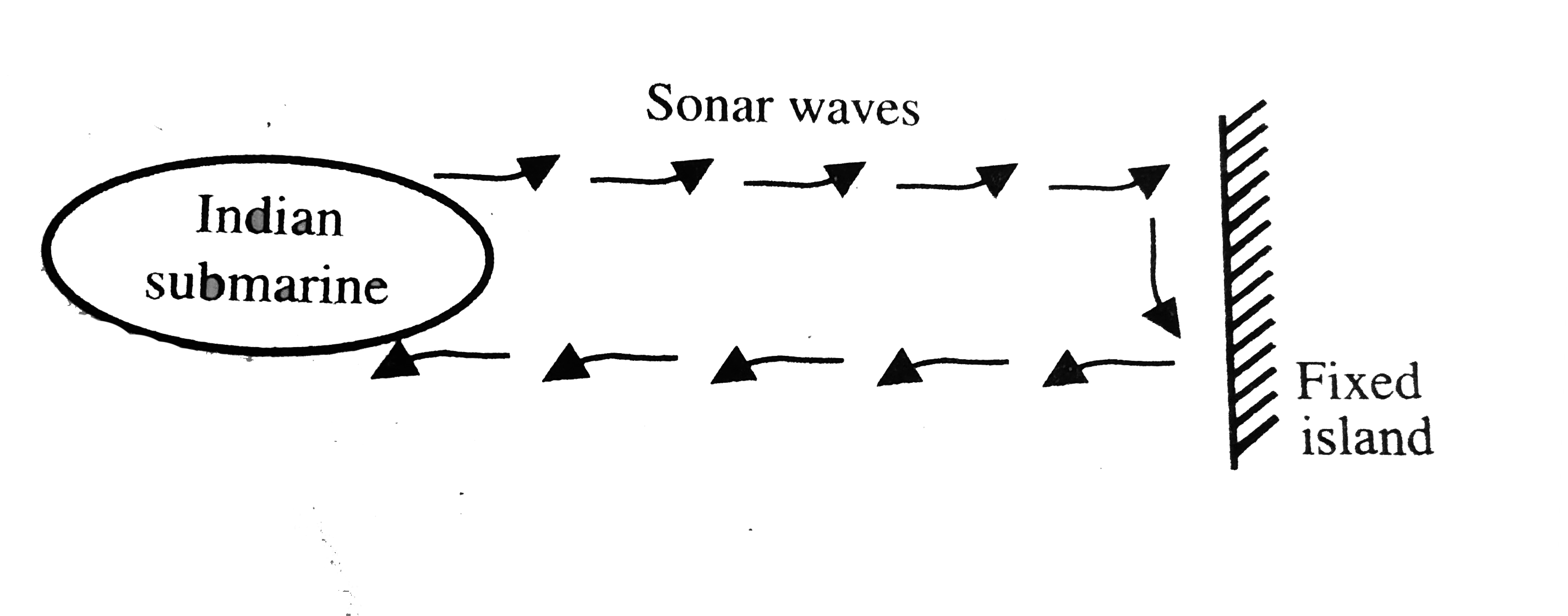 04:57View Solution
04:57View SolutionAn indian submarine is moving in the Arabian sea with constant velocity. To detect enemy it sends out sonar waves which travel with velocity `1050(m)/(s)` in water. Initially the waves are getting reflected from a fixed island and the reflected waves are coming back to submarine. The frequency of reflected waves are detected by the submarine and found to be `10%` greater than the sent waves.
Now an enemy ship comes in front, due to which the frequency of reflected waves detected by submarine becomes `21%` greater than the sent waves.
Q. The velocity of enemy ship should be
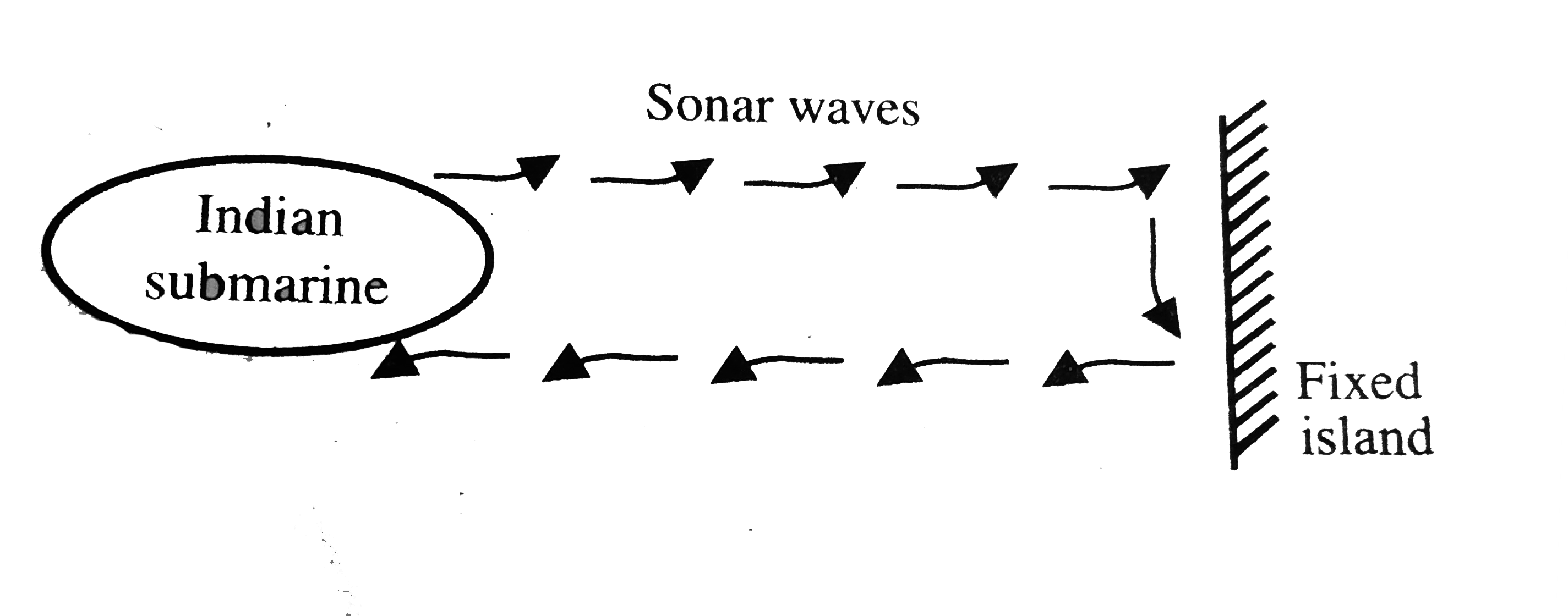 04:21View Solution
04:21View SolutionAn indian submarine is moving in the Arabian sea with constant velocity. To detect enemy it sends out sonar waves which travel with velocity `1050(m)/(s)` in water. Initially the waves are getting reflected from a fixed island and the reflected waves are coming back to submarine. The frequency of reflected waves are detected by the submarine and found to be `10%` greater than the sent waves.
Now an enemy ship comes in front, due to which the frequency of reflected waves detected by submarine becomes `21%` greater than the sent waves.
Q If the wavelength received by enemy ship is `lamda'` and wavelength of reflected waves received by submarine is `lamda''`, then `((lamda')/(lamda''))` equals
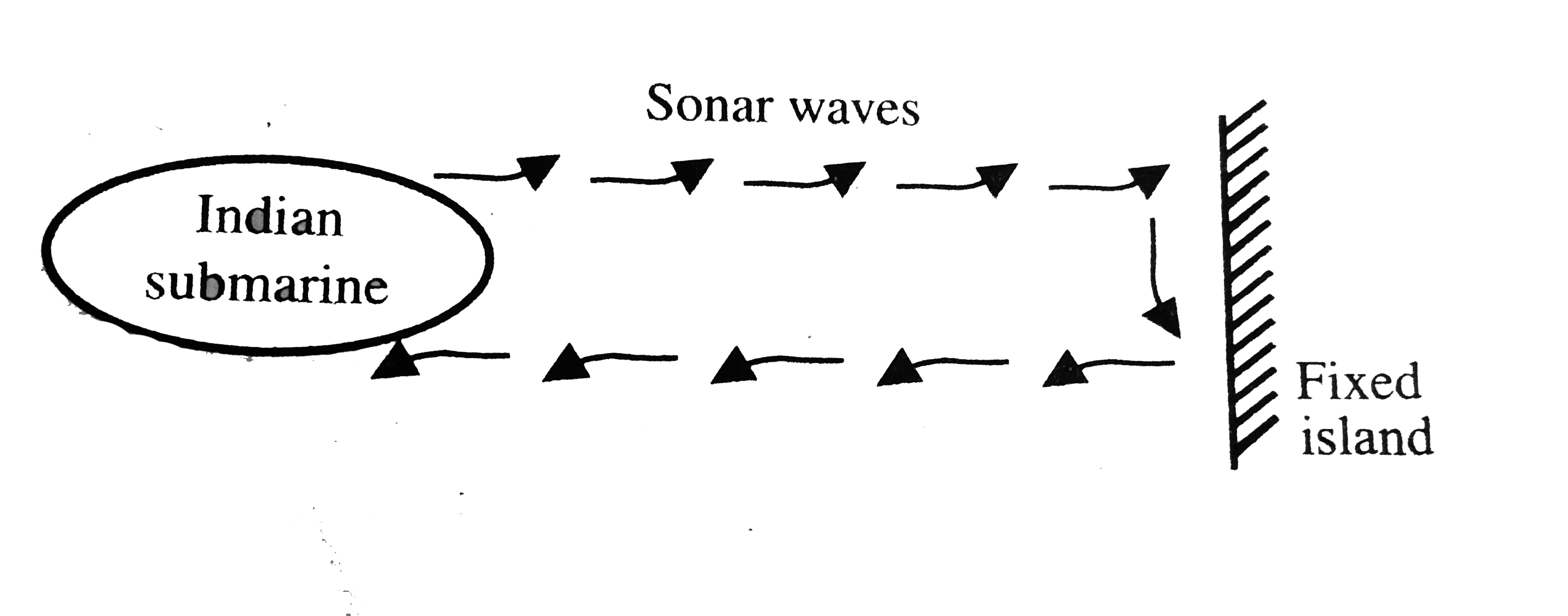 06:27View Solution
06:27View SolutionAn indian submarine is moving in the Arabian sea with constant velocity. To detect enemy it sends out sonar waves which travel with velocity `1050(m)/(s)` in water. Initially the waves are getting reflected from a fixed island and the reflected waves are coming back to submarine. The frequency of reflected waves are detected by the submarine and found to be `10%` greater than the sent waves.
Now an enemy ship comes in front, due to which the frequency of reflected waves detected by submarine becomes `21%` greater than the sent waves.
Q. Bulk modulus of sea water should be approximately `(rho=_(water)=1000(kg)/(m^3)`)
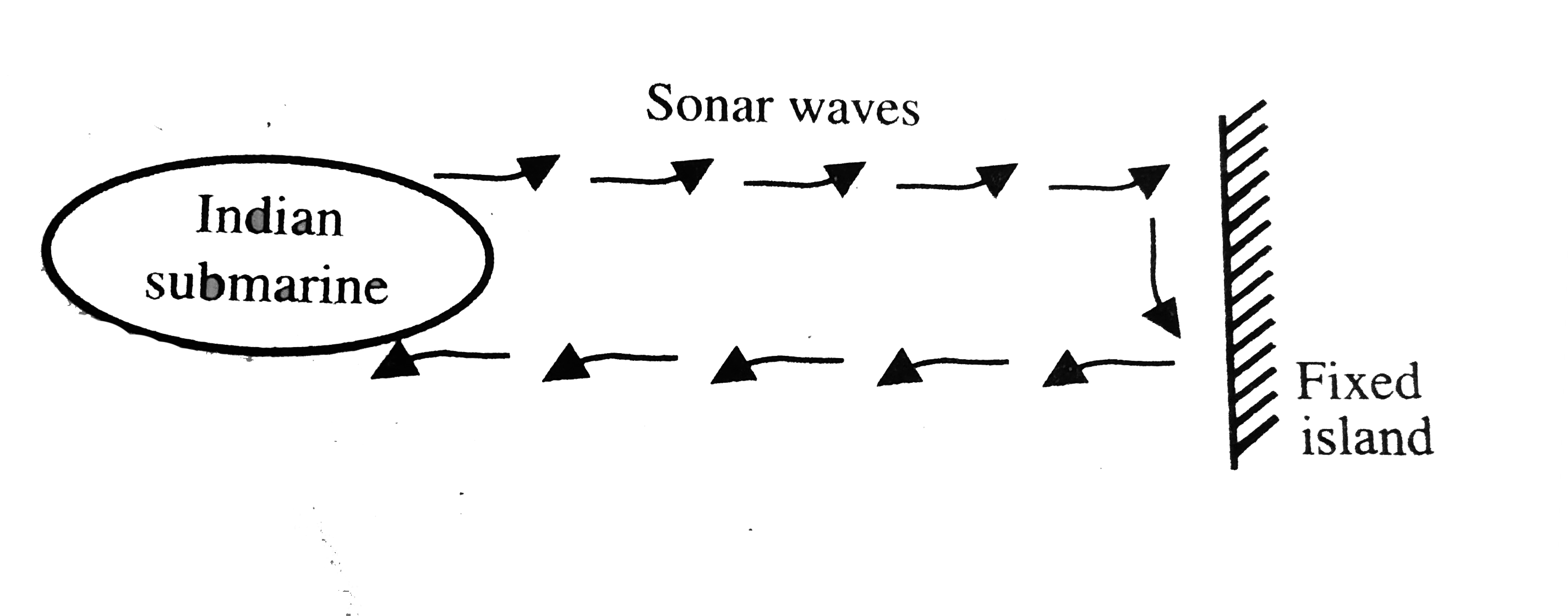 01:42View Solution
01:42View SolutionDue to point isotropic sound source, theintensity at a point is observed as 40 dB. The density of air is `rho=((15)/(11))(kg)/(m^3)` and velocity of sound in air is `330(m)/(s)`. Based on this information answer the following questions.
Q. The pressure amplitude at the observation point is03:04View SolutionDue to point isotropic sound source, theintensity at a point is observed as 40 dB. The density of air is `rho=((15)/(11))(kg)/(m^3)` and velocity of sound in air is `330(m)/(s)`. Based on this information answer the following questions.
Q. The ratio of displacement amplitude of wave at observation point to wavelength of sound waves is03:18View Solution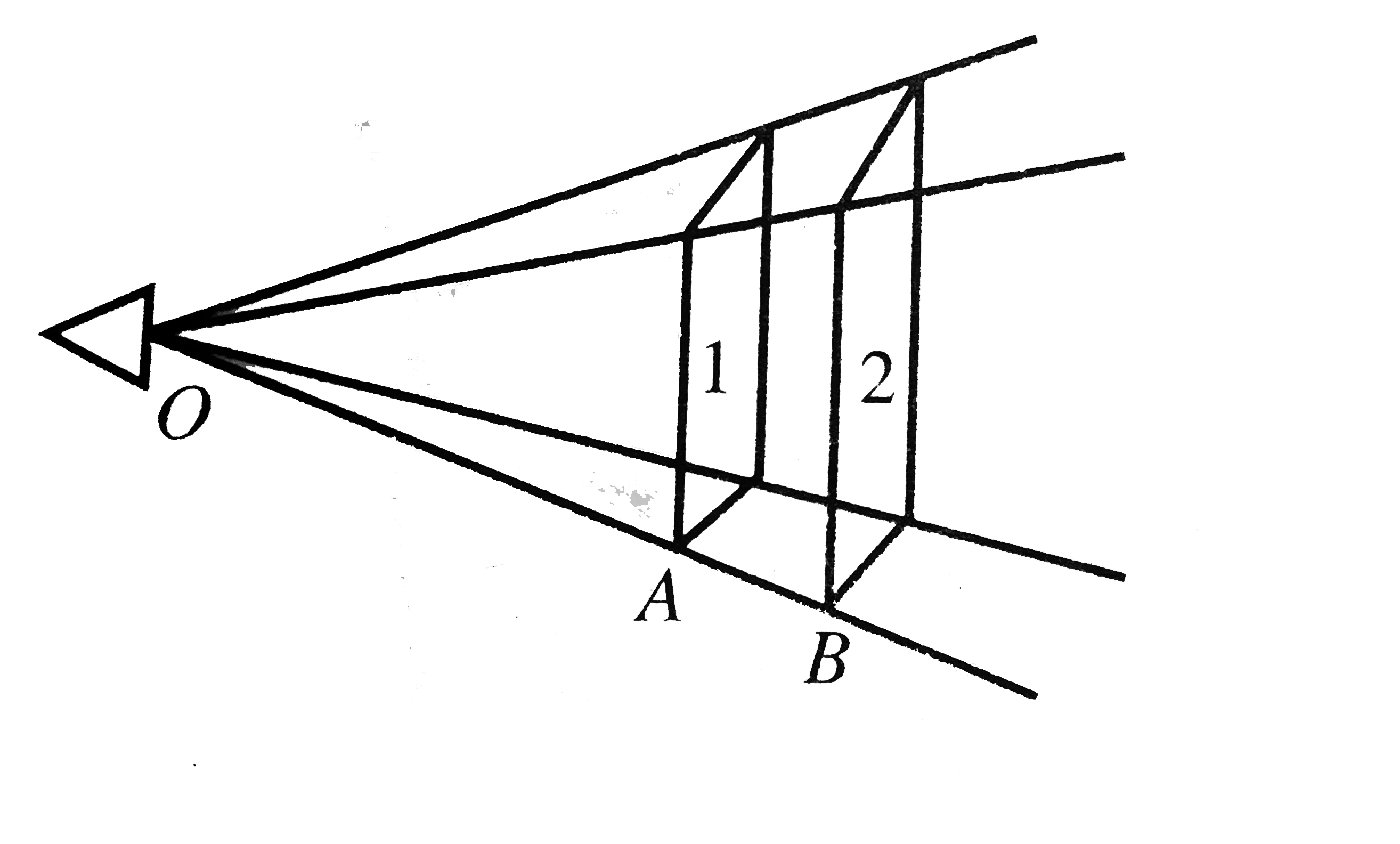
In the figure shown below, a source of sound having power `12xx10^-6W` is kept at `O`, which is emitting sound waves in the directions as shown. Two surfaces are labelled as 1 and 2 having areas `A_1=2xx10^3m^2` and `A_2=4xx10^3m^2`, respectively
Q. find the intensity at both the surfaces.02:15View Solution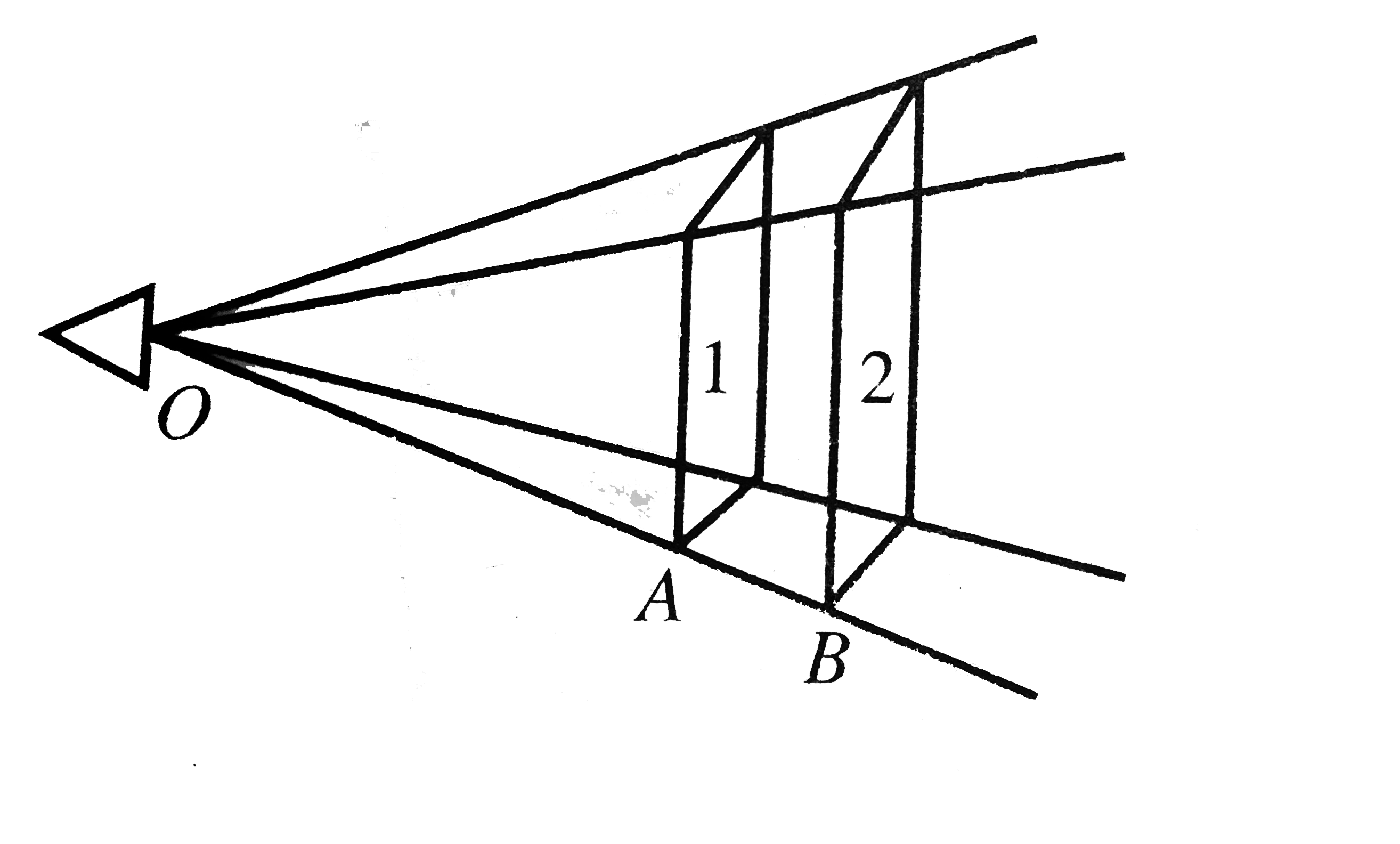
In the figure shown below, a source of sound having power `12xx10^-6W` is kept at `O`, which is emitting sound waves in the directions as shown. Two surfaces are labelled as 1 and 2 having areas `A_1=2xx10^3m^2` and `A_2=4xx10^3m^2`, respectively
Q. If two persons (having almost same physique) `A` and `B` are standing at the location of surfaces 1 and 2, respectively, then who will hear a quiter sound?02:00View Solution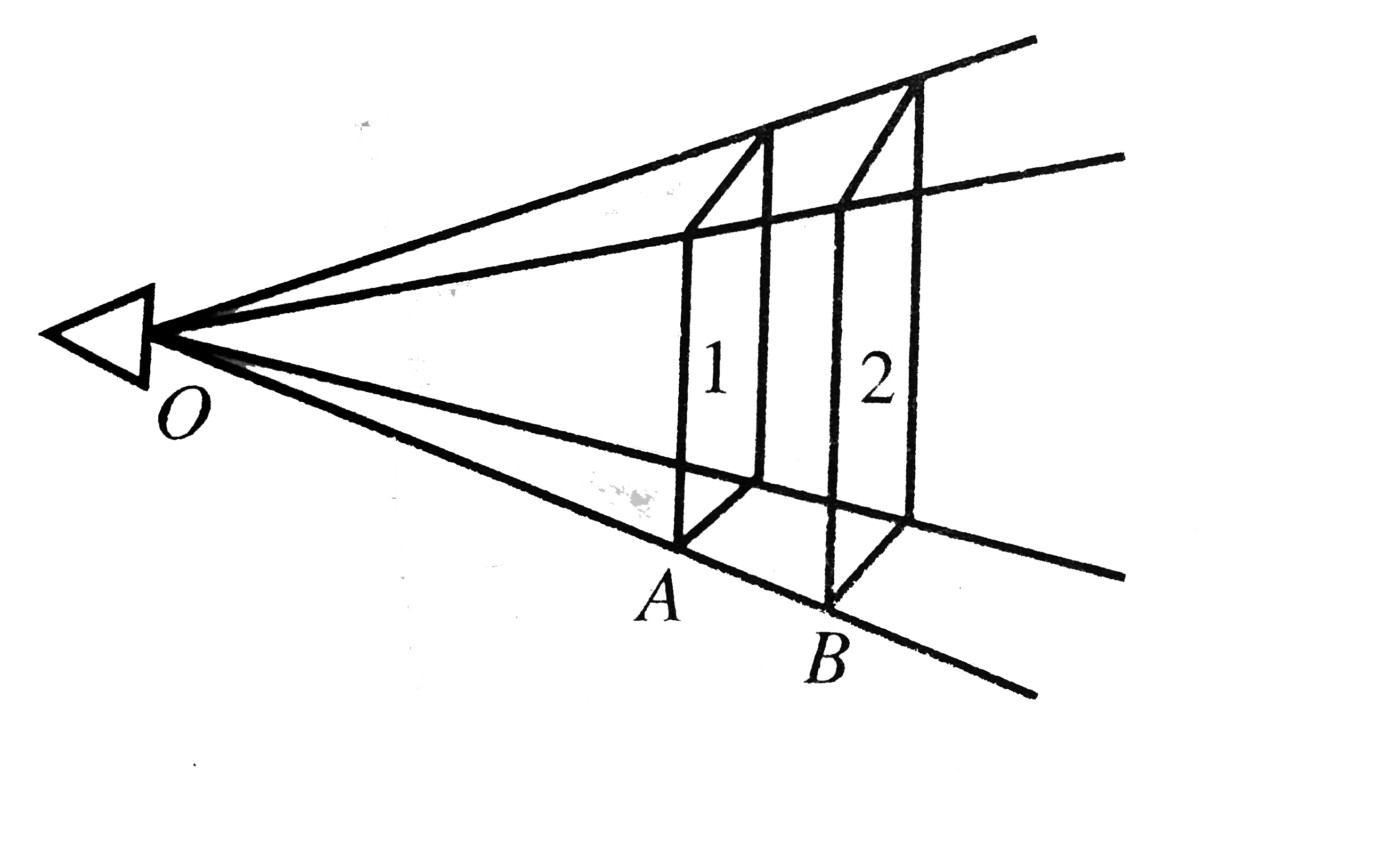
In the figure shown below, a source of sound having power `12xx10^-6W` is kept at `O`, which is emitting sound waves in the directions as shown. Two surfaces are labelled as 1 and 2 having areas `A_1=2xx10^3m^2` and `A_2=4xx10^3m^2`, respectively
Q. Let the areas of the eardrums of persons `A` and `B` be `A_A=2mm^2` and `A_B=4mm^2`, respectively. Then who will hear a quiter sound?03:07View Solution
When a sound wave enters the ear, it sets the eardrum into oscillation, which in turn causes oscillation of 3 tiny bones in the middle ear called ossicles. This oscillation is finally transmitted to the fluid filled in inner portion of the ear termed as inner ear, the motion of the fluid disturbs hair cells within the inner ear which transmit nerve impulses to the brain with the information that a sound is present. The theree bones present in the middle ear are named as hammer, anvil and stirrup. Out of these the stirrup is the smallest one and this only connects the middle ear to inner ear as shown in the figure below. The area of stirrup and its extent of connection with the inner ear limits the sensitivity of the human ear consider a person's ear whose moving part of the eardrum has an area of about `50mm^2` and the area of stirrup is about `5mm^2`. The mass of ossicles is negligible. As a result, force exerted by sound wave in air on eardum and ossicles is same as the force exerted by ossicles on the inner ear. Consider a sound wave having maximum pressure fluctuation of `4xx10^-2Pa` from its normal equilibrium pressure value which is equal to `10^5Pa`. Frequency of sound wave in air is `332(m)/(s)`. Velocity of sound wave in fluid (present in inner ear) is `1500(m)/(s)`. Bulk modulus of air is `1.42xx10^5Pa`. Bulk modulus of fluid is `2.18xx10^9Pa`.
Q. Find the pressure amplitude of given sound wave in the fluid of inner ear.16:48View Solution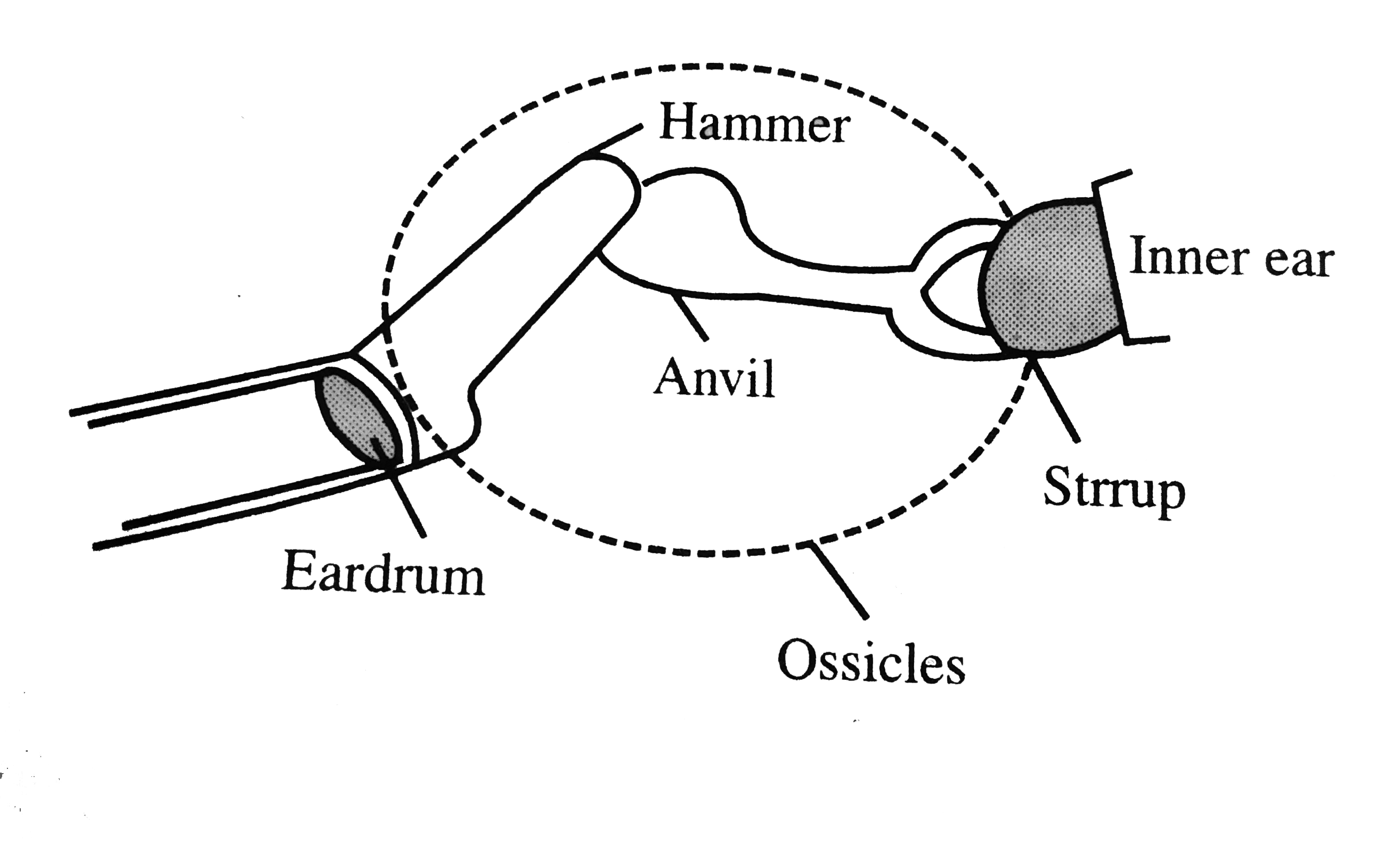
When a sound wave enters the ear, it sets the eardrum into oscillation, which in turn causes oscillation of 3 tiny bones in the middle ear called ossicles. This oscillation is finally transmitted to the fluid filled in inner portion of the ear termed as inner ear, the motion of the fluid disturbs hair cells within the inner ear which transmit nerve impulses to the brain with the information that a sound is present. The three bones present in the middle ear are named as hammer, anvil and stirrup. Out of these the stirrup is the smallest one and this only connects the middle ear to inner ear as shown in the figure below. The area of stirrup and its extent of connection with the inner ear limits the sensitivity of the human ear consider a person's ear whose moving part of the eardrum has an area of about `50mm^2` and the area of stirrup is about `5mm^2`. The mass of ossicles is negligible. As a result, force exerted by sound wave in air on eardrum and ossicles is same as the force exerted by ossicles on the inner ear. Consider a sound wave having maximum pressure fluctuation of `4xx10^-2Pa` from its normal equilibrium pressure value which is equal to `10^5Pa`. Frequency of sound wave in air is `332(m)/(s)`. Velocity of sound wave in fluid (present in inner ear) is `1500(m)/(s)`. Bulk modulus of air is `1.42xx10^5Pa`. Bulk modulus of fluid is `2.18xx10^9Pa`.
Q. Find the displacement amplitude of given sound wave in the fluid of inner ear.16:48View Solution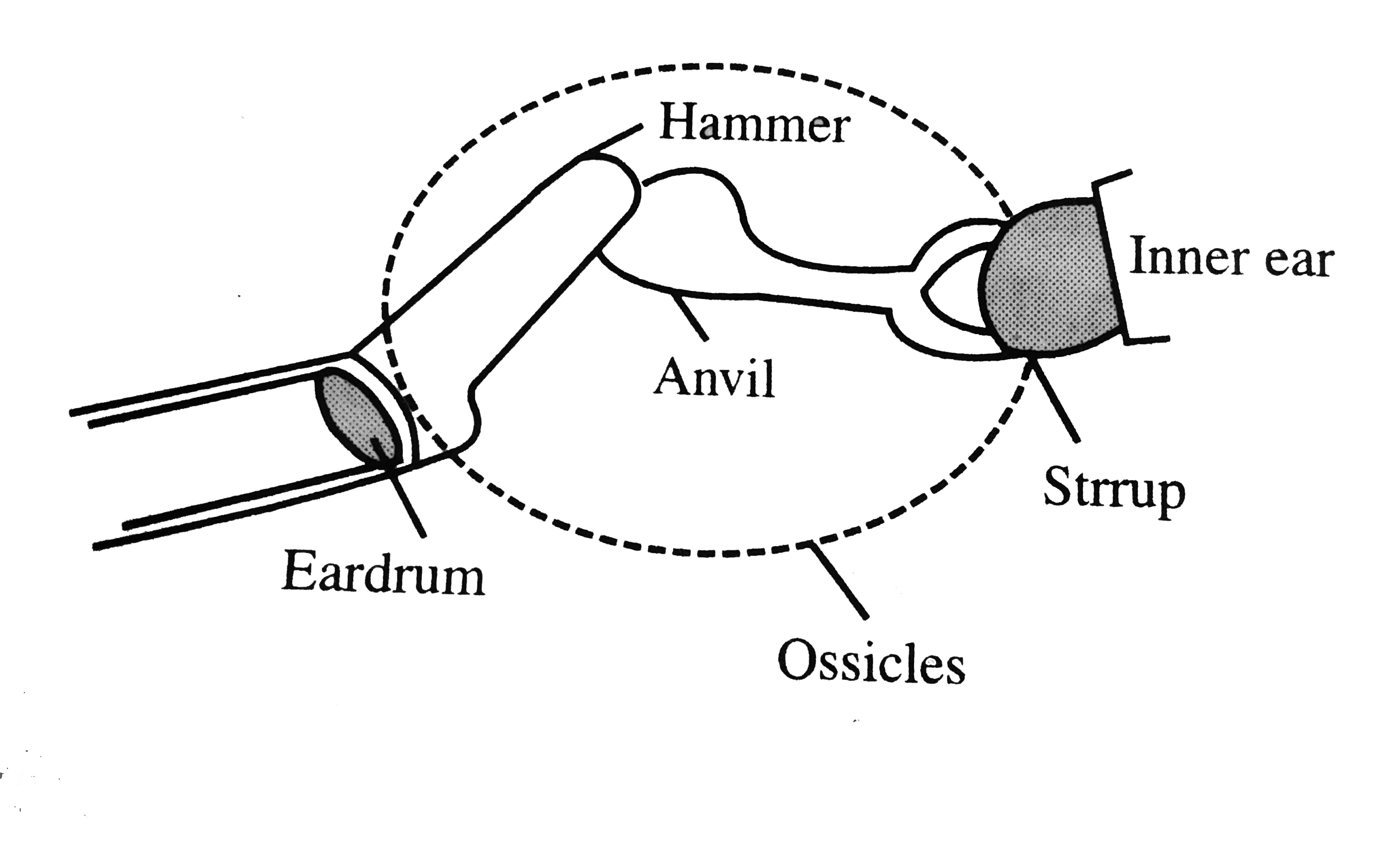
When a sound wave enters the ear, it sets the eardrum into oscillation, which in turn causes oscillation of 3 tiny bones in the middle ear called ossicles. This oscillation is finally transmitted to the fluid filled in inner portion of the ear termed as inner ear, the motion of the fluid disturbs hair cells within the inner ear which transmit nerve impulses to the brain with the information that a sound is present. The theree bones present in the middle ear are named as hammer, anvil and stirrup. Out of these the stirrup is the smallest one and this only connects the middle ear to inner ear as shown in the figure below. The area of stirrup and its extent of connection with the inner ear limits the sensitivity of the human ear consider a person's ear whose moving part of the eardrum has an area of about `50mm^2` and the area of stirrup is about `5mm^2`. The mass of ossicles is negligible. As a result, force exerted by sound wave in air on eardum and ossicles is same as the force exerted by ossicles on the inner ear. Consider a sound wave having maximum pressure fluctuation of `4xx10^-2Pa` from its normal equilibrium pressure value which is equal to `10^5Pa`. Frequency of sound wave in air is `332(m)/(s)`. Velocity of sound wave in fluid (present in inner ear) is `1500(m)/(s)`. Bulk modulus of air is `1.42xx10^5Pa`. Bulk modulus of fluid is `2.18xx10^9Pa`.
Q. If the person is using an hearing aid, which increase the intensity of given sound wave change as perceived by inner ear?16:48View Solution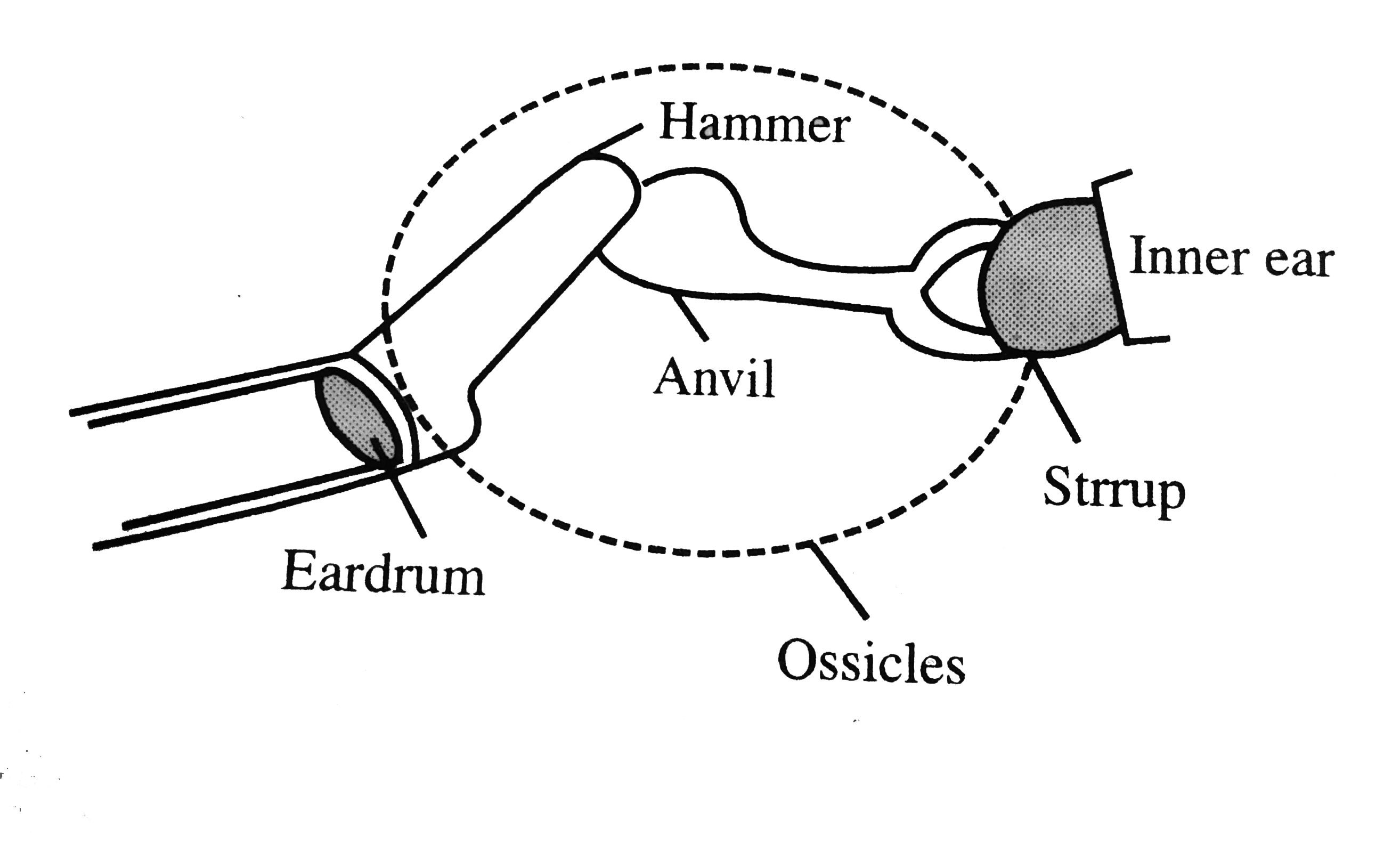
When a sound wave enters the ear, it sets the eardrum into oscillation, which in turn causes oscillation of 3 tiny bones in the middle ear called ossicles. This oscillation is finally transmitted to the fluid filled in inner portion of the ear termed as inner ear, the motion of the fluid disturbs hair cells within the inner ear which transmit nerve impulses to the brain with the information that a sound is present. The theree bones present in the middle ear are named as hammer, anvil and stirrup. Out of these the stirrup is the smallest one and this only connects the middle ear to inner ear as shown in the figure below. The area of stirrup and its extent of connection with the inner ear limits the sensitivity of the human ear consider a person's ear whose moving part of the eardrum has an area of about `50mm^2` and the area of stirrup is about `5mm^2`. The mass of ossicles is negligible. As a result, force exerted by sound wave in air on eardum and ossicles is same as the force exerted by ossicles on the inner ear. Consider a sound wave having maximum pressure fluctuation of `4xx10^-2Pa` from its normal equilibrium pressure value which is equal to `10^5Pa`. Frequency of sound wave in air is `332(m)/(s)`. Velocity of sound wave in fluid (present in inner ear) is `1500(m)/(s)`. Bulk modulus of air is `1.42xx10^5Pa`. Bulk modulus of fluid is `2.18xx10^9Pa`.
Q. This person (without hearing aid machine) is sitting inside a busy restaurant where average sound intensity is `3.2xx10^-5(W)/(m^2)`. How much energy in the form of sound is taken up by the person in his meal time of 1 h?16:48View Solution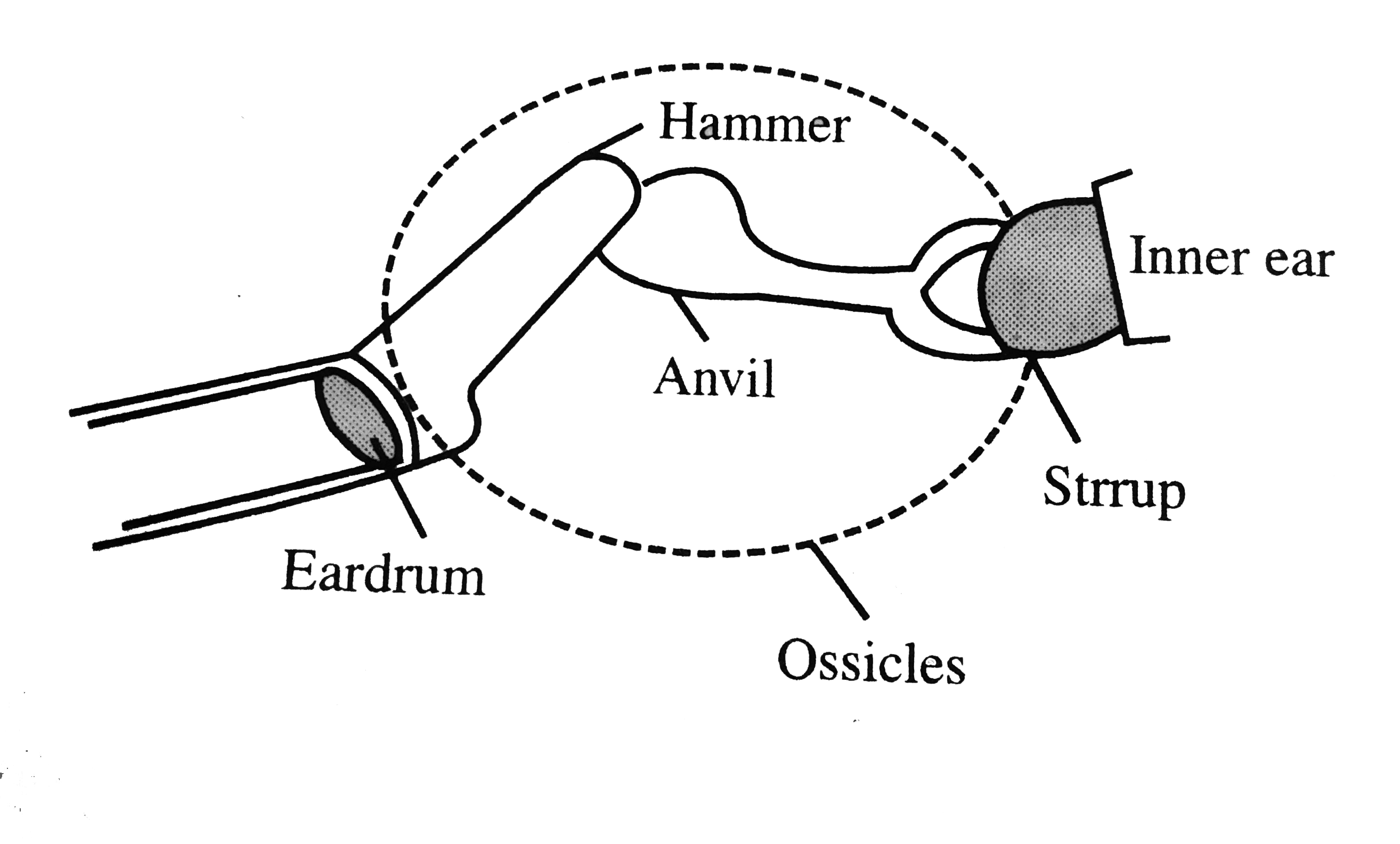
When a sound wave enters the ear, it sets the eardrum into oscillation, which in turn causes oscillation of 3 tiny bones in the middle ear called ossicles. This oscillation is finally transmitted to the fluid filled in inner portion of the ear termed as inner ear, the motion of the fluid disturbs hair cells within the inner ear which transmit nerve impulses to the brain with the information that a sound is present. The theree bones present in the middle ear are named as hammer, anvil and stirrup. Out of these the stirrup is the smallest one and this only connects the middle ear to inner ear as shown in the figure below. The area of stirrup and its extent of connection with the inner ear limits the sensitivity of the human ear consider a person's ear whose moving part of the eardrum has an area of about `50mm^2` and the area of stirrup is about `5mm^2`. The mass of ossicles is negligible. As a result, force exerted by sound wave in air on eardum and ossicles is same as the force exerted by ossicles on the inner ear. Consider a sound wave having maximum pressure fluctuation of `4xx10^-2Pa` from its normal equilibrium pressure value which is equal to `10^5Pa`. Frequency of sound wave in air is `332(m)/(s)`. Velocity of sound wave in fluid (present in inner ear) is `1500(m)/(s)`. Bulk modulus of air is `1.42xx10^5Pa`. Bulk modulus of fluid is `2.18xx10^9Pa`.
Q. With respect to information provided above, mark the correct statement.16:48View Solution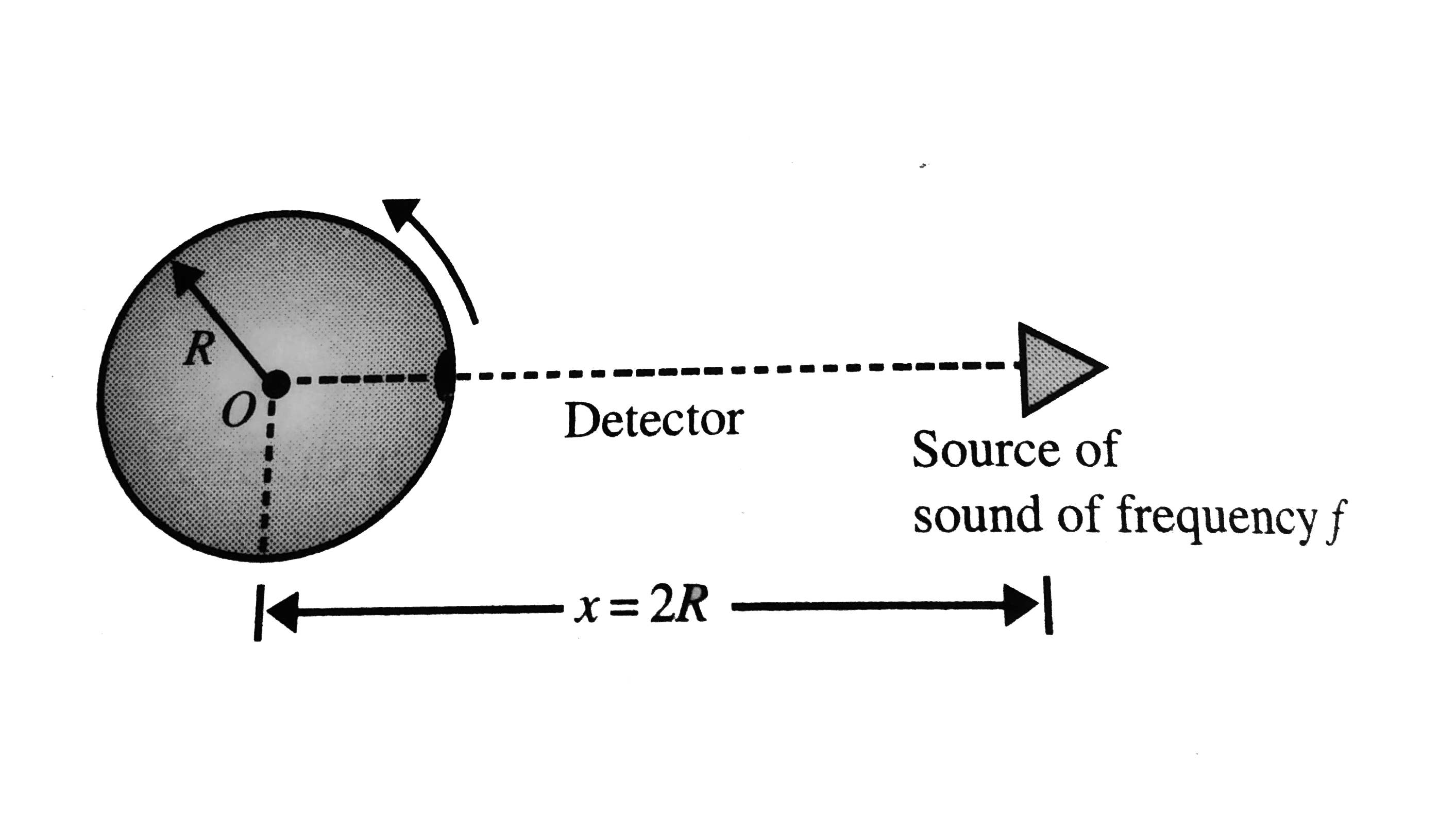
A source of sound and detector are arranged as shown in Fig. The detector is moving along a circle with constant angular speed `omega`. It start from the shown location in anticlockwise direction at `t=0`
(Take velocity of sound in air as v)
What is the frequency as received by detector, when it rotates by an angle `(pi)/(2)`?03:40View Solution
A source of sound and detector are arranged as shown in Fig. The detector is moving along a circle with constant angular speed `omega`. It start from the shown location in anticlockwise direction at `t=0`
(Take velocity of sound in air as v)
Q. Find the time at which the detector will hear the maximum frequency for the first time.03:16View Solution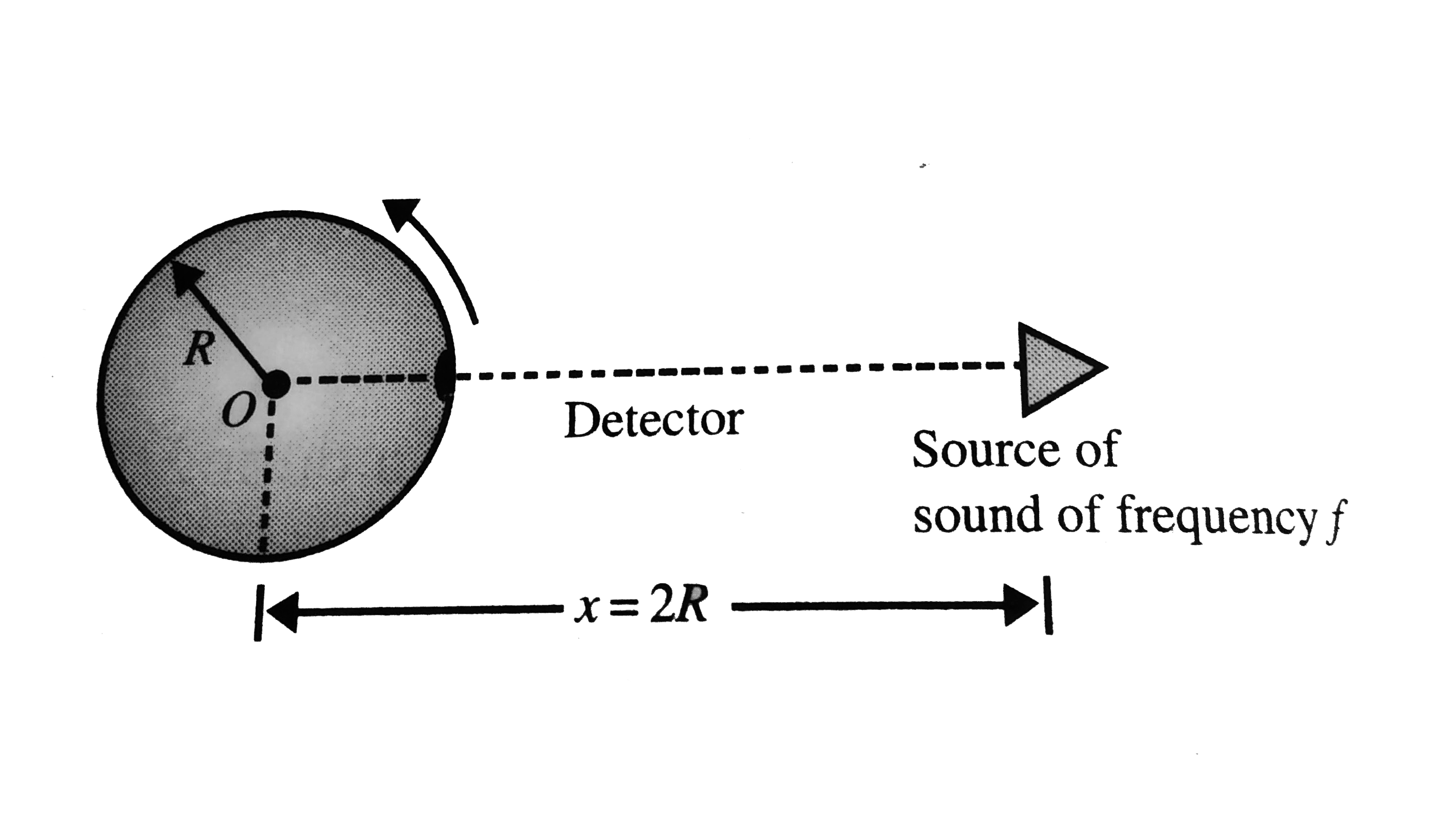
A source of sound and detector are arranged as shown in Fig. The detector is moving along a circle with constant angular speed `omega`. It start from the shown location in anticlockwise direction at `t=0`
(Take velocity of sound in air as v)
Find the time interval between minimum and maximum frequency as received by the detector.03:28View Solution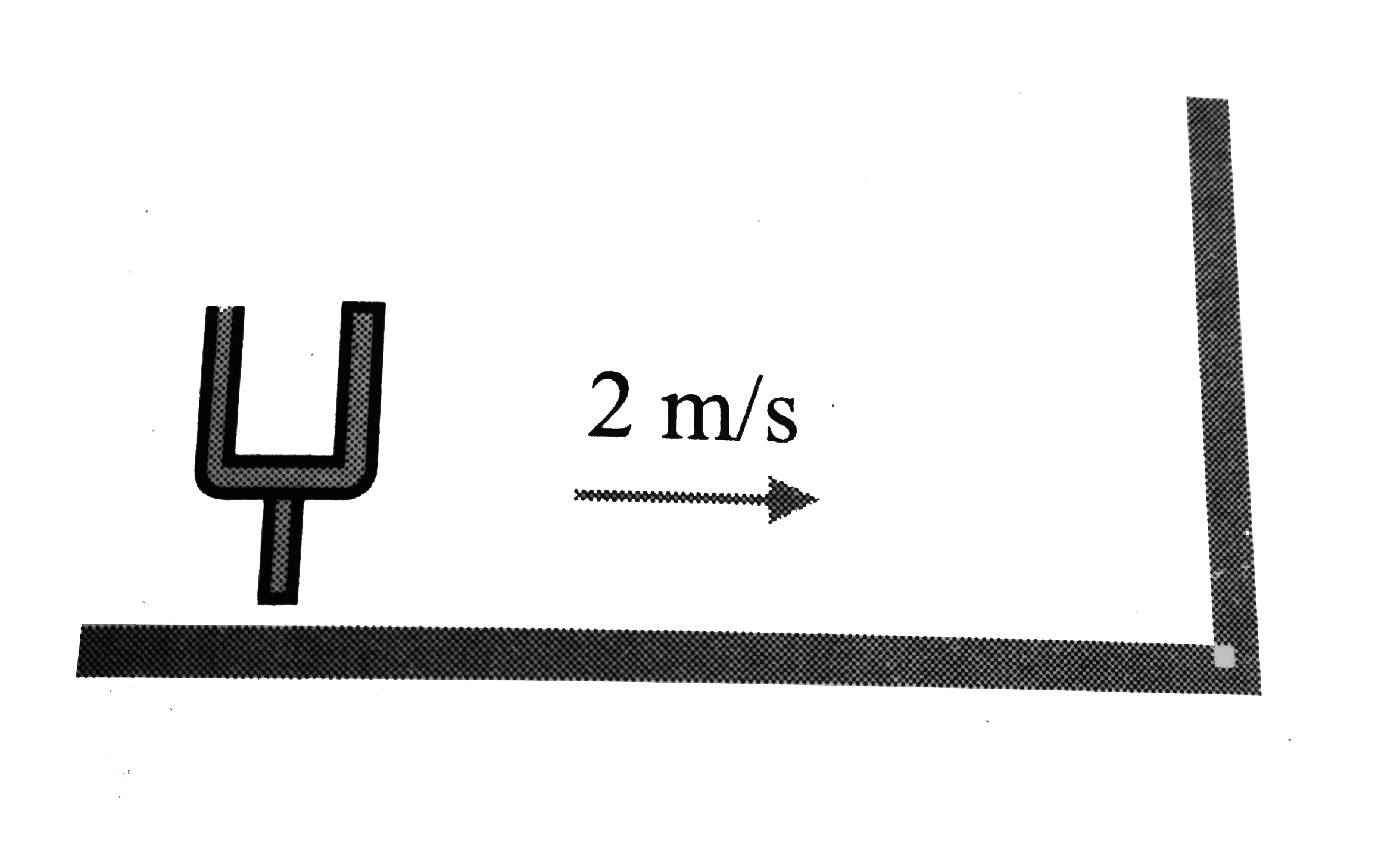
As shown if Fig. a vibrating tuning fork of frequency 512 Hz is moving towards the wall with a speed `2(m)/(s)`. Take speed of sound as `v=340(m)/(s)` and answer the following questions.
Q. Suppose that a listener is located at rest between the tuning fork and the wall. Number of beats heard by the listener per second will be10:51View Solution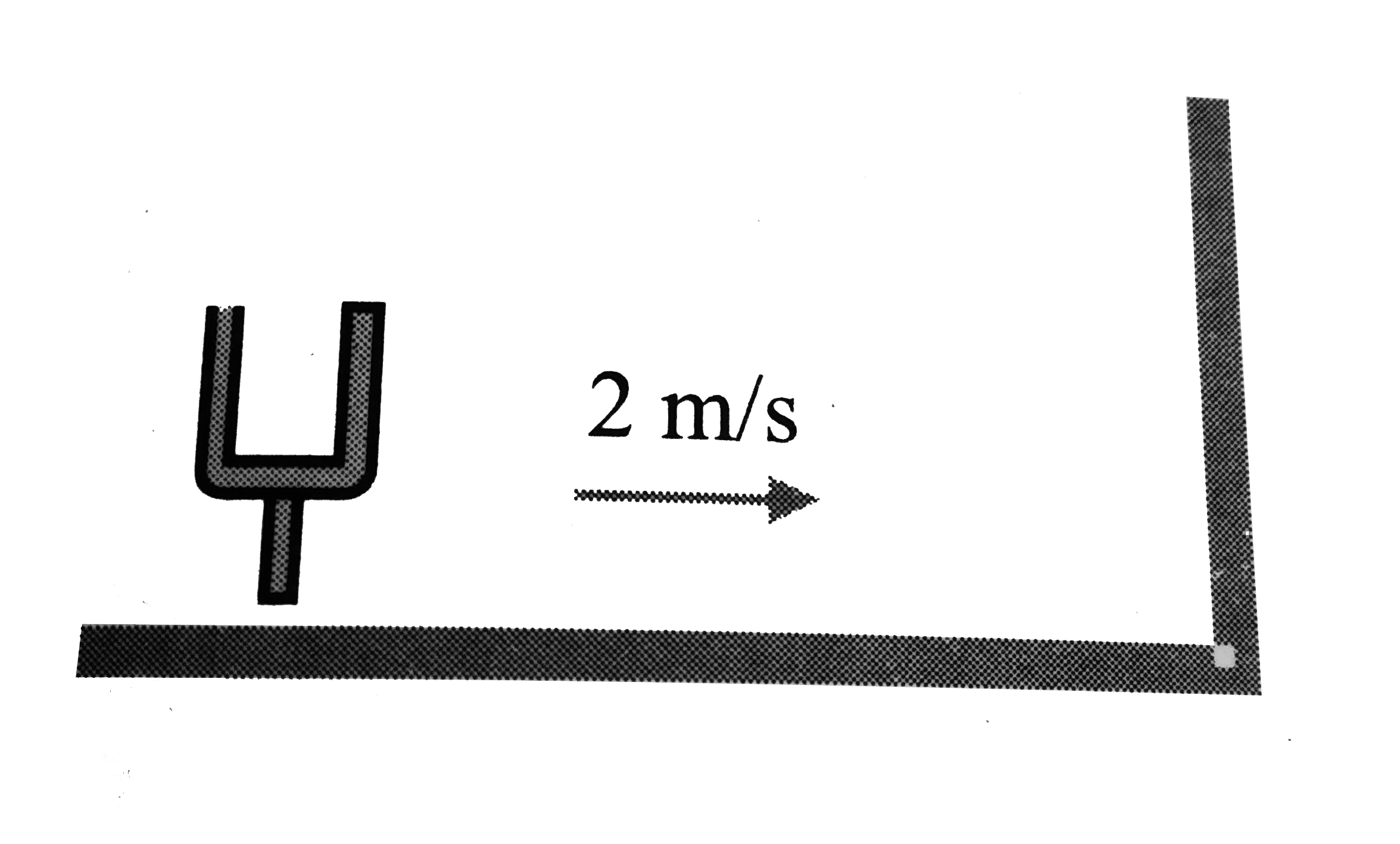
As shown if Fig. a vibrating tuning fork of frequency 512 Hz is moving towards the wall with a speed `2(m)/(s)`. Take speed of sound as `v=340(m)/(s)` and answer the following questions.
Q. If the listener is at rest and located such that the tuning fork is moving between the listener and the wall, number of beats heard by the listerner per second will be nearly10:51View Solution
As shown if Fig. a vibrating tuning fork of frequency 512 Hz is moving towards the wall with a speed `2(m)/(s)`. Take speed of sound as `v=340(m)/(s)` and answer the following questions.
Q. If the listener, along with the source, is moving towards the wall with the same speed i.e., `2(m)/(s)`, such that the source remains between the listerner and the wall, number of beats heard by the listerner per second will be10:51View Solution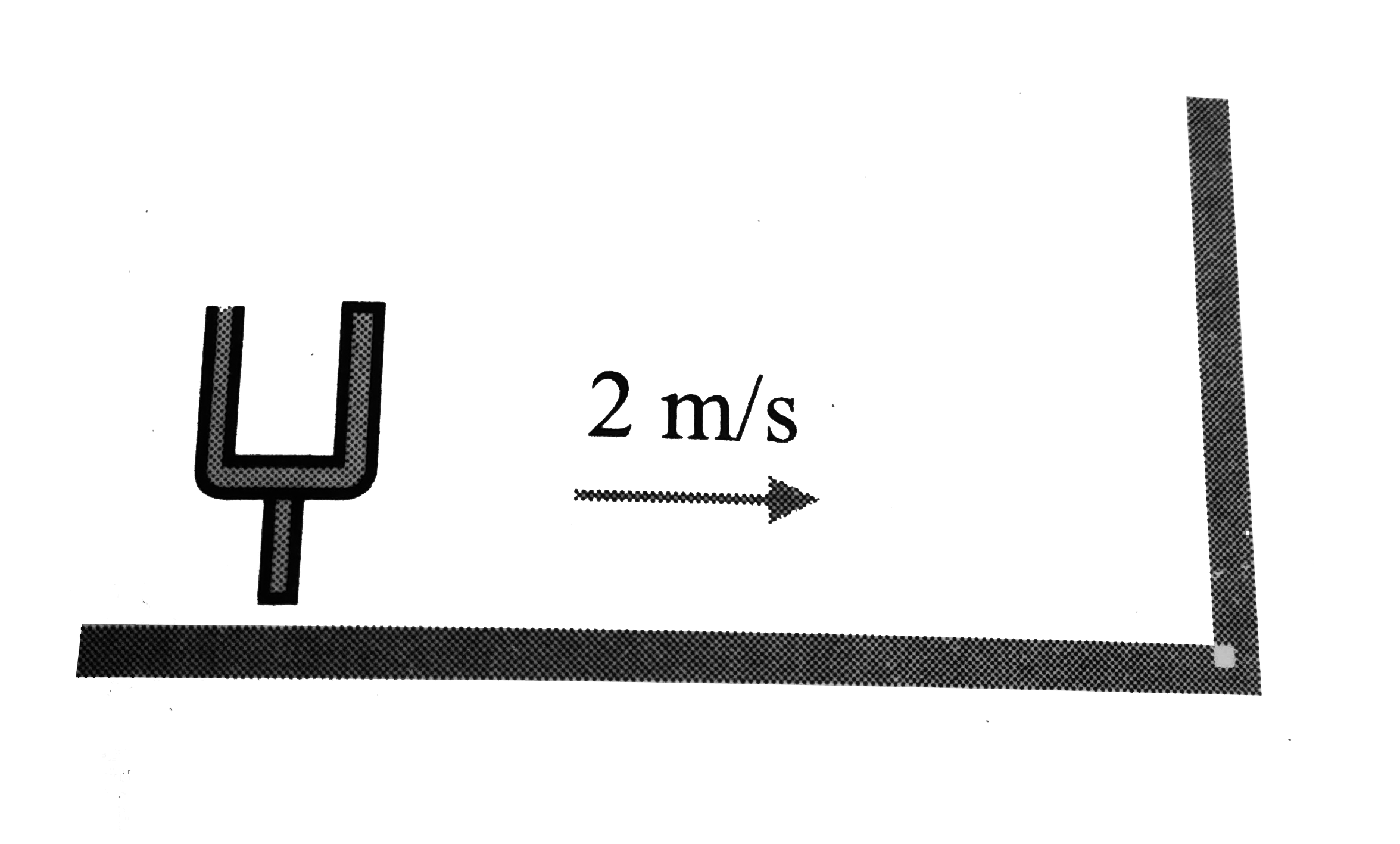
As shown if Fig. a vibrating tuning fork of frequency 512 Hz is moving towards the wall with a speed `2(m)/(s)`. Take speed of sound as `v=340(m)/(s)` and answer the following questions.
Q. If the listerner along with the source is moving towards the wall with the same speed i.e., `2(m)/(s)`, such that he (listener) remains between the source and the wall, number of beats heard by him will be10:51View SolutionA source of sound with natural frequency `f_0=1800Hz` moves uniformly along a straight line separated from a stationary observer by a distance `l=250m`. The velocity of the source is equal to `eta=0.80` fraction of the velocity of the sound.
Q. Find the frequency of osund received by the observer at the moment when the source gets closest to him.
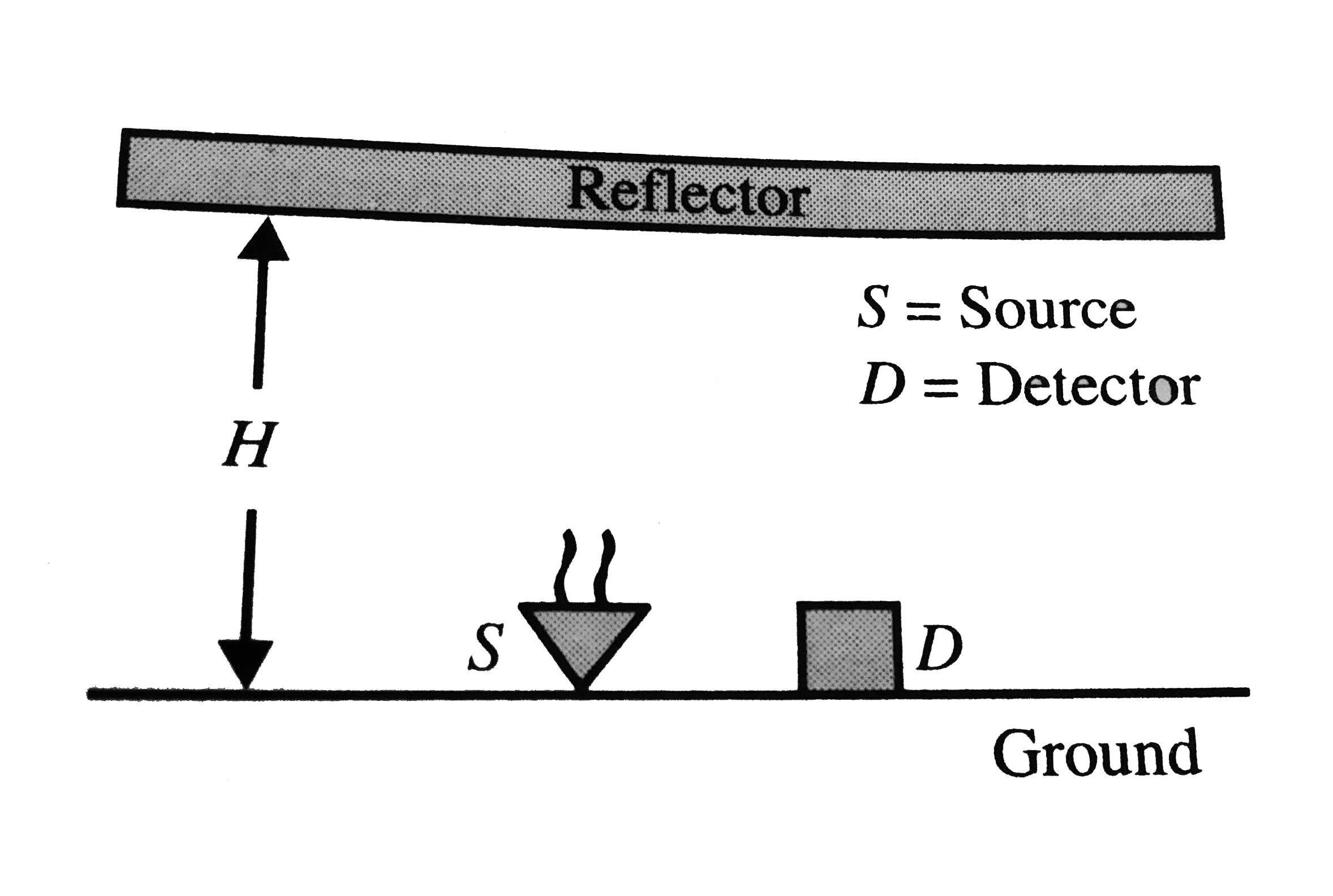 08:36View Solution
08:36View SolutionA source of sound with natural frequency `f_0=1800Hz` moves uniformly along a straight line separated from a stationary observer by a distance `l=250m`. The velocity of the source is equal to `eta=0.80` fraction of the velocity of the sound.
Q. The distance between the source and the observer at the moment when the observer receives a frequency `f=f_0` is
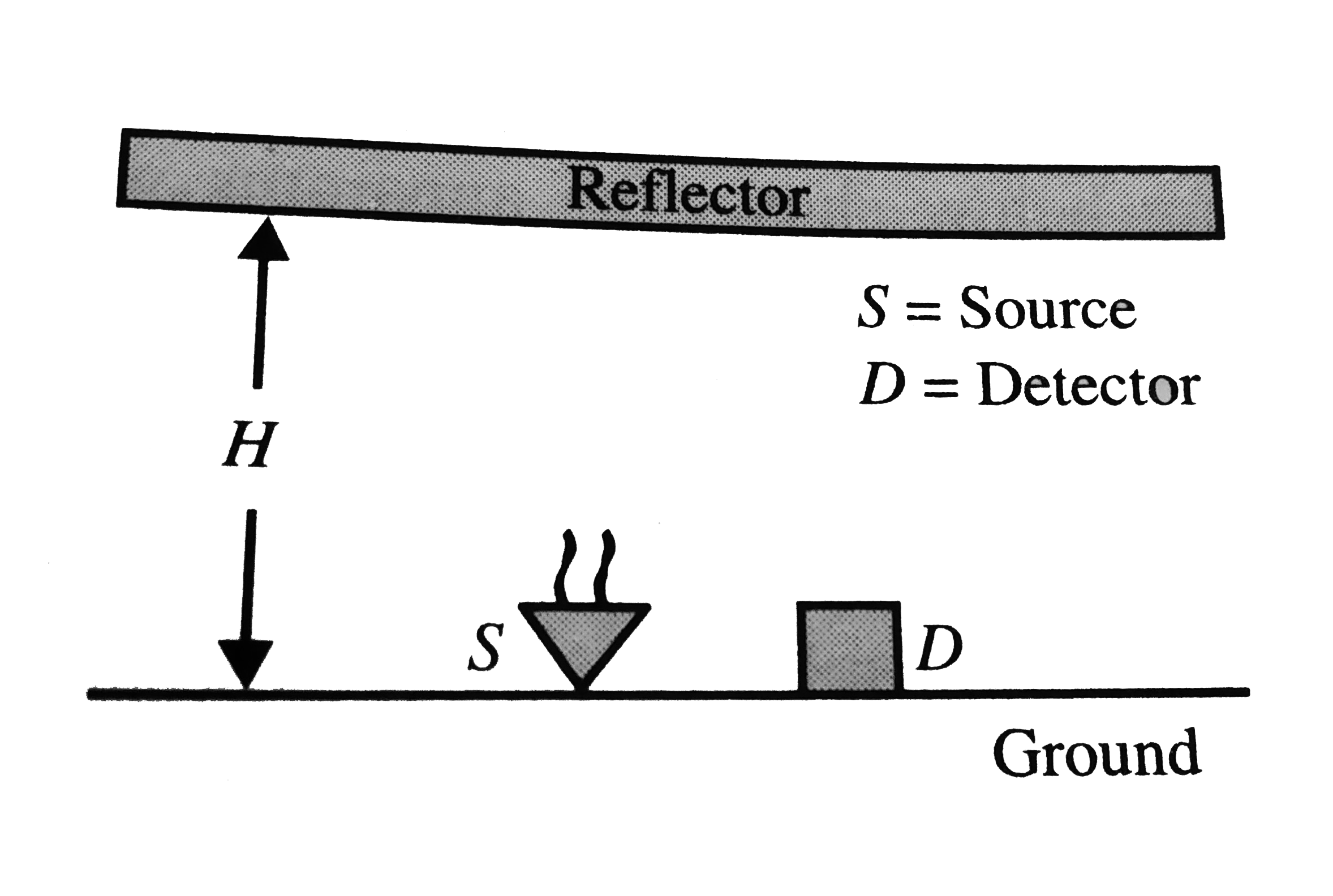 08:36View Solution
08:36View Solution
A source of sound and a detector are placed at the same place on ground At `t=0`, the source `S` is projected towards reflector with velocity `v_0` in vertical upward directon and reflector starts moving down with constant velocity `v_0` At `t-0`, the vertical separation between the reflector and source is `H((gtv_0^2)/(2g))`. The speed of sound in air is `v(gtgtv_0)`, Take `f_0` as the frequency of sound waves emitted by source. Based on above information answer the following questions.
Q. Frequency of sound waves emitted by source at `t=(v_0)/(2g)` is07:42View Solution
A source of sound and a detector are placed at the same place on ground At `t=0`, the source `S` is projected towards reflector with velocity `v_0` in vertical upward directon and reflector starts moving down with constant velocity `v_0` At `t-0`, the vertical separation between the reflector and source is `H((gtv_0^2)/(2g))`. The speed of sound in air is `v(gtgtv_0)`, Take `f_0` as the frequency of sound waves emitted by source. Based on above information answer the following questions.
Q. Wavelength of sound waves as received by detector before reflection at `t=(v_0)/(2g)` is07:42View Solution
A source of sound and a detector are placed at the same place on ground At `t=0`, the source `S` is projected towards reflector with velocity `v_0` in vertical upward directon and reflector starts moving down with constant velocity `v_0` At `t-0`, the vertical separation between the reflector and source is `H((gtv_0^2)/(2g))`. The speed of sound in air is `v(gtgtv_0)`, Take `f_0` as the frequency of sound waves emitted by source. Based on above information answer the following questions.
Q. Frequency of sound received by detector after being reflected by reflector at `t=(v_0)/(2g)` is07:42View SolutionA railroad train is travelling at `30(m)/(s)` in still air. The frequency of the note emitted by locomotive whistle is 500 Hz. Speed of sound is `345(m)/(s)`.
Q. What is the frequency of the sound waves heard by a stationary listener in front of the train?01:51View SolutionA railroad train is travelling at `30(m)/(s)` in still air. The frequency of the note emitted by locomotive whistle is 500 Hz. Speed of sound is `345(m)/(s)`.
Q. What is the frequency of the sound waves heard by a stationary listener behind the train?02:13View SolutionA source of sonic oscillation with frequency `n_0=600Hz` moves away and at right angles to a wall with velocity `u=30(m)/(s)`. A stationary reciever is located on the line of source in succession wall`rarr`source`rarr`receiver. If velocity of osund propagation is `v=330(m)/(s)`, then
Q. The beat frequency recorded by the receiver is03:28View SolutionA source of sonic oscillation with frequency `n_0=600Hz` moves away and at right angles to a wall with velocity `u=30(m)/(s)`. A stationary reciever is located on the line of source in succession wall`rarr`source`rarr`receiver. If velocity of osund propagation is `v=330(m)/(s)`, then
Q. The wavelength of direct waves received by the receiver is02:09View SolutionA source of sonic oscillation with frequency `n_0=600Hz` moves away and at right angles to a wall with velocity `u=30(m)/(s)`. A stationary reciever is located on the line of source in succession wall`rarr`source`rarr`receiver. If velocity of osund propagation is `v=330(m)/(s)`, then
Q. The wavelength of reflected waves received by the receiver is02:35View SolutionA source `S` of acoustic wave of the frequency `v_0=1700Hz` and a receiver `R` are located at the same point. At the instant `t=0`, the source start from rest to move away from the receiver with a constant acceleration `omega`. The velocity of sound in air is `v=340(m)/(s)`.
Q. If `omega=10(m)/(s^2)`, the apparent frequency that will be recorded by the stationary receiver at `t=10s` will be08:13View SolutionA source `S` of acoustic wave of the frequency `v_0=1700Hz` and a receiver `R` are located at the same point. At the instant `t=0`, the source start from rest to move away from the receiver with a constant acceleration `omega`. The velocity of sound in air is `v=340(m)/(s)`.
If `omega=10(m)/(s^2)` for 10s and then `omega=0` for `tgt10s`, the apparent frequency recorded by the receiver at `t=15s`08:13View SolutionA small source of sound vibrating frequency 500 Hz is rotated in a circle of radius `(100)/(pi)` cm at a constant angular speed of `5.0` revolutions per second. The speed of sound in air is `330(m)/(s)`.
Q. For an observer situated at a great distance on a straight line perpendicular to the plane of the circle, through its centre, the apparent frequency of the source will be02:24View SolutionA small source of sound vibrating frequency 500 Hz is rotated in a circle of radius `(100)/(pi)` cm at a constant angular speed of `5.0` revolutions per second. The speed of sound in air is `330(m)/(s)`.
Q. For an observer who is at rest at a great distance from the centre of the circle but nearly in the same plane, the minimum `f_(min)` and the maximum `f_(max)` of the range of values of the apparent frequency heard by him will be03:30View SolutionA small source of sound vibrating frequency 500 Hz is rotated in a circle of radius `(100)/(pi)` cm at a constant angular speed of `5.0` revolutions per second. The speed of sound in air is `330(m)/(s)`.
Q. If the observer moves towards the source with a constant speed of `20(m)/(s)`, along the radial line to the centre, the fractional change in the apparent frequency over the frequency that the source will have if considered at reat at the centre will be02:35View SolutionAn indian submarine is moving in the Arabian sea with constant velocity. To detect enemy it sends out sonar waves which travel with velocity `1050(m)/(s)` in water. Initially the waves are getting reflected from a fixed island and the reflected waves are coming back to submarine. The frequency of reflected waves are detected by the submarine and found to be `10%` greater than the sent waves.
Now an enemy ship comes in front, due to which the frequency of reflected waves detected by submarine becomes `21%` greater than the sent waves.
Q. The speed of indian submarine is
 04:57View Solution
04:57View SolutionAn indian submarine is moving in the Arabian sea with constant velocity. To detect enemy it sends out sonar waves which travel with velocity `1050(m)/(s)` in water. Initially the waves are getting reflected from a fixed island and the reflected waves are coming back to submarine. The frequency of reflected waves are detected by the submarine and found to be `10%` greater than the sent waves.
Now an enemy ship comes in front, due to which the frequency of reflected waves detected by submarine becomes `21%` greater than the sent waves.
Q. The velocity of enemy ship should be
 04:21View Solution
04:21View SolutionAn indian submarine is moving in the Arabian sea with constant velocity. To detect enemy it sends out sonar waves which travel with velocity `1050(m)/(s)` in water. Initially the waves are getting reflected from a fixed island and the reflected waves are coming back to submarine. The frequency of reflected waves are detected by the submarine and found to be `10%` greater than the sent waves.
Now an enemy ship comes in front, due to which the frequency of reflected waves detected by submarine becomes `21%` greater than the sent waves.
Q If the wavelength received by enemy ship is `lamda'` and wavelength of reflected waves received by submarine is `lamda''`, then `((lamda')/(lamda''))` equals
 06:27View Solution
06:27View SolutionAn indian submarine is moving in the Arabian sea with constant velocity. To detect enemy it sends out sonar waves which travel with velocity `1050(m)/(s)` in water. Initially the waves are getting reflected from a fixed island and the reflected waves are coming back to submarine. The frequency of reflected waves are detected by the submarine and found to be `10%` greater than the sent waves.
Now an enemy ship comes in front, due to which the frequency of reflected waves detected by submarine becomes `21%` greater than the sent waves.
Q. Bulk modulus of sea water should be approximately `(rho=_(water)=1000(kg)/(m^3)`)
 01:42View Solution
01:42View SolutionDue to point isotropic sound source, theintensity at a point is observed as 40 dB. The density of air is `rho=((15)/(11))(kg)/(m^3)` and velocity of sound in air is `330(m)/(s)`. Based on this information answer the following questions.
Q. The pressure amplitude at the observation point is03:04View SolutionDue to point isotropic sound source, the intensity at a point is observed as 40 dB. The density of air is `rho=((15)/(11))(kg)/(m^3)` and velocity of sound in air is `330(m)/(s)`. Based on this information answer the following questions.
Q. The ratio of displacement amplitude of wave at observation point to wavelength of sound waves is03:18View Solution
In the figure shown below, a source of sound having power `12xx10^-6W` is kept at `O`, which is emitting sound waves in the directions as shown. Two surfaces are labelled as 1 and 2 having areas `A_1=2xx10^3m^2` and `A_2=4xx10^3m^2`, respectively
Q. find the intensity at both the surfaces.02:15View Solution
In the figure shown below, a source of sound having power `12xx10^-6W` is kept at `O`, which is emitting sound waves in the directions as shown. Two surfaces are labelled as 1 and 2 having areas `A_1=2xx10^3m^2` and `A_2=4xx10^3m^2`, respectively
Q. If two persons (having almost same physique) `A` and `B` are standing at the location of surfaces 1 and 2, respectively, then who will hear a quiter sound?02:00View Solution
In the figure shown below, a source of sound having power `12xx10^-6W` is kept at `O`, which is emitting sound waves in the directions as shown. Two surfaces are labelled as 1 and 2 having areas `A_1=2xx10^3m^2` and `A_2=4xx10^3m^2`, respectively
Q. Let the areas of the eardrums of persons `A` and `B` be `A_A=2mm^2` and `A_B=4mm^2`, respectively. Then who will hear a quiter sound?03:07View Solution
When a sound wave enters the ear, it sets the eardrum into oscillation, which in turn causes oscillation of 3 tiny bones in the middle ear called ossicles. This oscillation is finally transmitted to the fluid filled in inner portion of the ear termed as inner ear, the motion of the fluid disturbs hair cells within the inner ear which transmit nerve impulses to the brain with the information that a sound is present. The theree bones present in the middle ear are named as hammer, anvil and stirrup. Out of these the stirrup is the smallest one and this only connects the middle ear to inner ear as shown in the figure below. The area of stirrup and its extent of connection with the inner ear limits the sensitivity of the human ear consider a person's ear whose moving part of the eardrum has an area of about `50mm^2` and the area of stirrup is about `5mm^2`. The mass of ossicles is negligible. As a result, force exerted by sound wave in air on eardum and ossicles is same as the force exerted by ossicles on the inner ear. Consider a sound wave having maximum pressure fluctuation of `4xx10^-2Pa` from its normal equilibrium pressure value which is equal to `10^5Pa`. Frequency of sound wave in air is `332(m)/(s)`. Velocity of sound wave in fluid (present in inner ear) is `1500(m)/(s)`. Bulk modulus of air is `1.42xx10^5Pa`. Bulk modulus of fluid is `2.18xx10^9Pa`.
Q. Find the pressure amplitude of given sound wave in the fluid of inner ear.16:48View Solution
When a sound wave enters the ear, it sets the eardrum into oscillation, which in turn causes oscillation of 3 tiny bones in the middle ear called ossicles. This oscillation is finally transmitted to the fluid filled in inner portion of the ear termed as inner ear, the motion of the fluid disturbs hair cells within the inner ear which transmit nerve impulses to the brain with the information that a sound is present. The theree bones present in the middle ear are named as hammer, anvil and stirrup. Out of these the stirrup is the smallest one and this only connects the middle ear to inner ear as shown in the figure below. The area of stirrup and its extent of connection with the inner ear limits the sensitivity of the human ear consider a person's ear whose moving part of the eardrum has an area of about `50mm^2` and the area of stirrup is about `5mm^2`. The mass of ossicles is negligible. As a result, force exerted by sound wave in air on eardum and ossicles is same as the force exerted by ossicles on the inner ear. Consider a sound wave having maximum pressure fluctuation of `4xx10^-2Pa` from its normal equilibrium pressure value which is equal to `10^5Pa`. Frequency of sound wave in air is `332(m)/(s)`. Velocity of sound wave in fluid (present in inner ear) is `1500(m)/(s)`. Bulk modulus of air is `1.42xx10^5Pa`. Bulk modulus of fluid is `2.18xx10^9Pa`.
Q. Find the displacement amplitude of given sound wave in the fluid of inner ear.16:48View Solution
When a sound wave enters the ear, it sets the eardrum into oscillation, which in turn causes oscillation of 3 tiny bones in the middle ear called ossicles. This oscillation is finally transmitted to the fluid filled in inner portion of the ear termed as inner ear, the motion of the fluid disturbs hair cells within the inner ear which transmit nerve impulses to the brain with the information that a sound is present. The theree bones present in the middle ear are named as hammer, anvil and stirrup. Out of these the stirrup is the smallest one and this only connects the middle ear to inner ear as shown in the figure below. The area of stirrup and its extent of connection with the inner ear limits the sensitivity of the human ear consider a person's ear whose moving part of the eardrum has an area of about `50mm^2` and the area of stirrup is about `5mm^2`. The mass of ossicles is negligible. As a result, force exerted by sound wave in air on eardum and ossicles is same as the force exerted by ossicles on the inner ear. Consider a sound wave having maximum pressure fluctuation of `4xx10^-2Pa` from its normal equilibrium pressure value which is equal to `10^5Pa`. Frequency of sound wave in air is `332(m)/(s)`. Velocity of sound wave in fluid (present in inner ear) is `1500(m)/(s)`. Bulk modulus of air is `1.42xx10^5Pa`. Bulk modulus of fluid is `2.18xx10^9Pa`.
Q. If the person is using an hearing aid, which increase the intensity of given sound wave change as perceived by inner ear?16:48View Solution
When a sound wave enters the ear, it sets the eardrum into oscillation, which in turn causes oscillation of 3 tiny bones in the middle ear called ossicles. This oscillation is finally transmitted to the fluid filled in inner portion of the ear termed as inner ear, the motion of the fluid disturbs hair cells within the inner ear which transmit nerve impulses to the brain with the information that a sound is present. The theree bones present in the middle ear are named as hammer, anvil and stirrup. Out of these the stirrup is the smallest one and this only connects the middle ear to inner ear as shown in the figure below. The area of stirrup and its extent of connection with the inner ear limits the sensitivity of the human ear consider a person's ear whose moving part of the eardrum has an area of about `50mm^2` and the area of stirrup is about `5mm^2`. The mass of ossicles is negligible. As a result, force exerted by sound wave in air on eardum and ossicles is same as the force exerted by ossicles on the inner ear. Consider a sound wave having maximum pressure fluctuation of `4xx10^-2Pa` from its normal equilibrium pressure value which is equal to `10^5Pa`. Frequency of sound wave in air is `332(m)/(s)`. Velocity of sound wave in fluid (present in inner ear) is `1500(m)/(s)`. Bulk modulus of air is `1.42xx10^5Pa`. Bulk modulus of fluid is `2.18xx10^9Pa`.
Q. This person (without hearing aid machine) is sitting inside a busy restaurant where average sound intensity is `3.2xx10^-5(W)/(m^2)`. How much energy in the form of sound is taken up by the person in his meal time of 1 h?16:48View Solution
When a sound wave enters the ear, it sets the eardrum into oscillation, which in turn causes oscillation of 3 tiny bones in the middle ear called ossicles. This oscillation is finally transmitted to the fluid filled in inner portion of the ear termed as inner ear, the motion of the fluid disturbs hair cells within the inner ear which transmit nerve impulses to the brain with the information that a sound is present. The theree bones present in the middle ear are named as hammer, anvil and stirrup. Out of these the stirrup is the smallest one and this only connects the middle ear to inner ear as shown in the figure below. The area of stirrup and its extent of connection with the inner ear limits the sensitivity of the human ear consider a person's ear whose moving part of the eardrum has an area of about `50mm^2` and the area of stirrup is about `5mm^2`. The mass of ossicles is negligible. As a result, force exerted by sound wave in air on eardum and ossicles is same as the force exerted by ossicles on the inner ear. Consider a sound wave having maximum pressure fluctuation of `4xx10^-2Pa` from its normal equilibrium pressure value which is equal to `10^5Pa`. Frequency of sound wave in air is `332(m)/(s)`. Velocity of sound wave in fluid (present in inner ear) is `1500(m)/(s)`. Bulk modulus of air is `1.42xx10^5Pa`. Bulk modulus of fluid is `2.18xx10^9Pa`.
Q. With respect to information provided above, mark the correct statement.16:48View Solution
A source of sound and detector are arranged as shown in Fig. The detector is moving along a circle with constant angular speed `omega`. It start from the shown location in anticlockwise direction at `t=0`
(Take velocity of sound in air as v)
What is the frequency as received by detector, when it rotates by an angle `(pi)/(2)`?03:40View Solution
A source of sound and detector are arranged as shown in Fig. The detector is moving along a circle with constant angular speed `omega`. It start from the shown location in anticlockwise direction at `t=0`
(Take velocity of sound in air as v)
Q. Find the time at which the detector will hear the maximum frequency for the first time.03:16View Solution
A source of sound and detector are arranged as shown in Fig. The detector is moving along a circle with constant angular speed `omega`. It start from the shown location in anticlockwise direction at `t=0`
(Take velocity of sound in air as v)
Find the time interval between minimum and maximum frequency as received by the detector.03:28View Solution
As shown if Fig. a vibrating tuning fork of frequency 512 Hz is moving towards the wall with a speed `2(m)/(s)`. Take speed of sound as `v=340(m)/(s)` and answer the following questions.
Q. Suppose that a listener is located at rest between the tuning fork and the wall. Number of beats heard by the listener per second will be10:51View Solution
As shown if Fig. a vibrating tuning fork of frequency 512 Hz is moving towards the wall with a speed `2(m)/(s)`. Take speed of sound as `v=340(m)/(s)` and answer the following questions.
Q. If the listener is at rest and located such that the tuning fork is moving between the listener and the wall, number of beats heard by the listerner per second will be nearly10:51View Solution
As shown if Fig. a vibrating tuning fork of frequency 512 Hz is moving towards the wall with a speed `2(m)/(s)`. Take speed of sound as `v=340(m)/(s)` and answer the following questions.
Q. If the listener, along with the source, is moving towards the wall with the same speed i.e., `2(m)/(s)`, such that the source remains between the listerner and the wall, number of beats heard by the listerner per second will be10:51View Solution
As shown if Fig. a vibrating tuning fork of frequency 512 Hz is moving towards the wall with a speed `2(m)/(s)`. Take speed of sound as `v=340(m)/(s)` and answer the following questions.
Q. If the listerner along with the source is moving towards the wall with the same speed i.e., `2(m)/(s)`, such that he (listener) remains between the source and the wall, number of beats heard by him will be10:51View SolutionA source of sound with natural frequency `f_0=1800Hz` moves uniformly along a straight line separated from a stationary observer by a distance `l=250m`. The velocity of the source is equal to `eta=0.80` fraction of the velocity of the sound.
Q. Find the frequency of osund received by the observer at the moment when the source gets closest to him.
 08:36View Solution
08:36View SolutionA source of sound with natural frequency `f_0=1800Hz` moves uniformly along a straight line separated from a stationary observer by a distance `l=250m`. The velocity of the source is equal to `eta=0.80` fraction of the velocity of the sound.
Q. The distance between the source and the observer at the moment when the observer receives a frequency `f=f_0` is
 08:36View Solution
08:36View Solution
A source of sound and a detector are placed at the same place on ground At `t=0`, the source `S` is projected towards reflector with velocity `v_0` in vertical upward directon and reflector starts moving down with constant velocity `v_0` At `t-0`, the vertical separation between the reflector and source is `H((gtv_0^2)/(2g))`. The speed of sound in air is `v(gtgtv_0)`, Take `f_0` as the frequency of sound waves emitted by source. Based on above information answer the following questions.
Q. Frequency of sound waves emitted by source at `t=(v_0)/(2g)` is07:42View Solution
A source of sound and a detector are placed at the same place on ground At `t=0`, the source `S` is projected towards reflector with velocity `v_0` in vertical upward directon and reflector starts moving down with constant velocity `v_0` At `t-0`, the vertical separation between the reflector and source is `H((gtv_0^2)/(2g))`. The speed of sound in air is `v(gtgtv_0)`, Take `f_0` as the frequency of sound waves emitted by source. Based on above information answer the following questions.
Q. Wavelength of sound waves as received by detector before reflection at `t=(v_0)/(2g)` is07:42View Solution
A source of sound and a detector are placed at the same place on ground At `t=0`, the source `S` is projected towards reflector with velocity `v_0` in vertical upward directon and reflector starts moving down with constant velocity `v_0` At `t-0`, the vertical separation between the reflector and source is `H((gtv_0^2)/(2g))`. The speed of sound in air is `v(gtgtv_0)`, Take `f_0` as the frequency of sound waves emitted by source. Based on above information answer the following questions.
Q. Frequency of sound received by detector after being reflected by reflector at `t=(v_0)/(2g)` is07:42View SolutionA railroad train is travelling at `30(m)/(s)` in still air. The frequency of the note emitted by locomotive whistle is 500 Hz. Speed of sound is `345(m)/(s)`.
Q. What is the frequency of the sound waves heard by a stationary listener in front of the train?01:51View SolutionA railroad train is travelling at `30(m)/(s)` in still air. The frequency of the note emitted by locomotive whistle is 500 Hz. Speed of sound is `345(m)/(s)`.
Q. What is the frequency of the sound waves heard by a stationary listener behind the train?02:13View SolutionA source of sonic oscillation with frequency `n_0=600Hz` moves away and at right angles to a wall with velocity `u=30(m)/(s)`. A stationary reciever is located on the line of source in succession wall`rarr`source`rarr`receiver. If velocity of osund propagation is `v=330(m)/(s)`, then
Q. The beat frequency recorded by the receiver is03:28View SolutionA source of sonic oscillation with frequency `n_0=600Hz` moves away and at right angles to a wall with velocity `u=30(m)/(s)`. A stationary reciever is located on the line of source in succession wall`rarr`source`rarr`receiver. If velocity of osund propagation is `v=330(m)/(s)`, then
Q. The wavelength of direct waves received by the receiver is02:09View SolutionA source of sonic oscillation with frequency `n_0=600Hz` moves away and at right angles to a wall with velocity `u=30(m)/(s)`. A stationary reciever is located on the line of source in succession wall`rarr`source`rarr`receiver. If velocity of osund propagation is `v=330(m)/(s)`, then
Q. The wavelength of reflected waves received by the receiver is02:35View SolutionA source `S` of acoustic wave of the frequency `v_0=1700Hz` and a receiver `R` are located at the same point. At the instant `t=0`, the source start from rest to move away from the receiver with a constant acceleration `omega`. The velocity of sound in air is `v=340(m)/(s)`.
Q. If `omega=10(m)/(s^2)`, the apparent frequency that will be recorded by the stationary receiver at `t=10s` will be08:13View SolutionA source `S` of acoustic wave of the frequency `v_0=1700Hz` and a receiver `R` are located at the same point. At the instant `t=0`, the source start from rest to move away from the receiver with a constant acceleration `omega`. The velocity of sound in air is `v=340(m)/(s)`.
If `omega=10(m)/(s^2)` for 10s and then `omega=0` for `tgt10s`, the apparent frequency recorded by the receiver at `t=15s`08:13View SolutionA small source of sound vibrating frequency 500 Hz is rotated in a circle of radius `(100)/(pi)` cm at a constant angular speed of `5.0` revolutions per second. The speed of sound in air is `330(m)/(s)`.
Q. For an observer situated at a great distance on a straight line perpendicular to the plane of the circle, through its centre, the apparent frequency of the source will be02:24View SolutionA small source of sound vibrating frequency 500 Hz is rotated in a circle of radius `(100)/(pi)` cm at a constant angular speed of `5.0` revolutions per second. The speed of sound in air is `330(m)/(s)`.
Q. For an observer who is at rest at a great distance from the centre of the circle but nearly in the same plane, the minimum `f_(min)` and the maximum `f_(max)` of the range of values of the apparent frequency heard by him will be03:30View SolutionA small source of sound vibrating frequency 500 Hz is rotated in a circle of radius `(100)/(pi)` cm at a constant angular speed of `5.0` revolutions per second. The speed of sound in air is `330(m)/(s)`.
Q. If the observer moves towards the source with a constant speed of `20(m)/(s)`, along the radial line to the centre, the fractional change in the apparent frequency over the frequency that the source will have if considered at reat at the centre will be02:35View SolutionAn indian submarine is moving in the Arabian sea with constant velocity. To detect enemy it sends out sonar waves which travel with velocity `1050(m)/(s)` in water. Initially the waves are getting reflected from a fixed island and the reflected waves are coming back to submarine. The frequency of reflected waves are detected by the submarine and found to be `10%` greater than the sent waves.
Now an enemy ship comes in front, due to which the frequency of reflected waves detected by submarine becomes `21%` greater than the sent waves.
Q. The speed of indian submarine is
 04:57View Solution
04:57View SolutionAn indian submarine is moving in the Arabian sea with constant velocity. To detect enemy it sends out sonar waves which travel with velocity `1050(m)/(s)` in water. Initially the waves are getting reflected from a fixed island and the reflected waves are coming back to submarine. The frequency of reflected waves are detected by the submarine and found to be `10%` greater than the sent waves.
Now an enemy ship comes in front, due to which the frequency of reflected waves detected by submarine becomes `21%` greater than the sent waves.
Q. The velocity of enemy ship should be
 04:21View Solution
04:21View SolutionAn indian submarine is moving in the Arabian sea with constant velocity. To detect enemy it sends out sonar waves which travel with velocity `1050(m)/(s)` in water. Initially the waves are getting reflected from a fixed island and the reflected waves are coming back to submarine. The frequency of reflected waves are detected by the submarine and found to be `10%` greater than the sent waves.
Now an enemy ship comes in front, due to which the frequency of reflected waves detected by submarine becomes `21%` greater than the sent waves.
Q If the wavelength received by enemy ship is `lamda'` and wavelength of reflected waves received by submarine is `lamda''`, then `((lamda')/(lamda''))` equals
 06:27View Solution
06:27View SolutionAn indian submarine is moving in the Arabian sea with constant velocity. To detect enemy it sends out sonar waves which travel with velocity `1050(m)/(s)` in water. Initially the waves are getting reflected from a fixed island and the reflected waves are coming back to submarine. The frequency of reflected waves are detected by the submarine and found to be `10%` greater than the sent waves.
Now an enemy ship comes in front, due to which the frequency of reflected waves detected by submarine becomes `21%` greater than the sent waves.
Q. Bulk modulus of sea water should be approximately `(rho=_(water)=1000(kg)/(m^3)`)
 01:42View Solution
01:42View SolutionDue to point isotropic sound source, theintensity at a point is observed as 40 dB. The density of air is `rho=((15)/(11))(kg)/(m^3)` and velocity of sound in air is `330(m)/(s)`. Based on this information answer the following questions.
Q. The pressure amplitude at the observation point is03:04View SolutionDue to point isotropic sound source, the intensity at a point is observed as 40 dB. The density of air is `rho=((15)/(11))(kg)/(m^3)` and velocity of sound in air is `330(m)/(s)`. Based on this information answer the following questions.
Q. The ratio of displacement amplitude of wave at observation point to wavelength of sound waves is03:18View Solution
In the figure shown below, a source of sound having power `12xx10^-6W` is kept at `O`, which is emitting sound waves in the directions as shown. Two surfaces are labelled as 1 and 2 having areas `A_1=2xx10^3m^2` and `A_2=4xx10^3m^2`, respectively
Q. find the intensity at both the surfaces.02:15View Solution
In the figure shown below, a source of sound having power `12xx10^-6W` is kept at `O`, which is emitting sound waves in the directions as shown. Two surfaces are labelled as 1 and 2 having areas `A_1=2xx10^3m^2` and `A_2=4xx10^3m^2`, respectively
Q. If two persons (having almost same physique) `A` and `B` are standing at the location of surfaces 1 and 2, respectively, then who will hear a quiter sound?02:00View Solution
In the figure shown below, a source of sound having power `12xx10^-6W` is kept at `O`, which is emitting sound waves in the directions as shown. Two surfaces are labelled as 1 and 2 having areas `A_1=2xx10^3m^2` and `A_2=4xx10^3m^2`, respectively
Q. Let the areas of the eardrums of persons `A` and `B` be `A_A=2mm^2` and `A_B=4mm^2`, respectively. Then who will hear a quiter sound?03:07View Solution
When a sound wave enters the ear, it sets the eardrum into oscillation, which in turn causes oscillation of 3 tiny bones in the middle ear called ossicles. This oscillation is finally transmitted to the fluid filled in inner portion of the ear termed as inner ear, the motion of the fluid disturbs hair cells within the inner ear which transmit nerve impulses to the brain with the information that a sound is present. The theree bones present in the middle ear are named as hammer, anvil and stirrup. Out of these the stirrup is the smallest one and this only connects the middle ear to inner ear as shown in the figure below. The area of stirrup and its extent of connection with the inner ear limits the sensitivity of the human ear consider a person's ear whose moving part of the eardrum has an area of about `50mm^2` and the area of stirrup is about `5mm^2`. The mass of ossicles is negligible. As a result, force exerted by sound wave in air on eardum and ossicles is same as the force exerted by ossicles on the inner ear. Consider a sound wave having maximum pressure fluctuation of `4xx10^-2Pa` from its normal equilibrium pressure value which is equal to `10^5Pa`. Frequency of sound wave in air is `332(m)/(s)`. Velocity of sound wave in fluid (present in inner ear) is `1500(m)/(s)`. Bulk modulus of air is `1.42xx10^5Pa`. Bulk modulus of fluid is `2.18xx10^9Pa`.
Q. Find the pressure amplitude of given sound wave in the fluid of inner ear.16:48View Solution
When a sound wave enters the ear, it sets the eardrum into oscillation, which in turn causes oscillation of 3 tiny bones in the middle ear called ossicles. This oscillation is finally transmitted to the fluid filled in inner portion of the ear termed as inner ear, the motion of the fluid disturbs hair cells within the inner ear which transmit nerve impulses to the brain with the information that a sound is present. The theree bones present in the middle ear are named as hammer, anvil and stirrup. Out of these the stirrup is the smallest one and this only connects the middle ear to inner ear as shown in the figure below. The area of stirrup and its extent of connection with the inner ear limits the sensitivity of the human ear consider a person's ear whose moving part of the eardrum has an area of about `50mm^2` and the area of stirrup is about `5mm^2`. The mass of ossicles is negligible. As a result, force exerted by sound wave in air on eardum and ossicles is same as the force exerted by ossicles on the inner ear. Consider a sound wave having maximum pressure fluctuation of `4xx10^-2Pa` from its normal equilibrium pressure value which is equal to `10^5Pa`. Frequency of sound wave in air is `332(m)/(s)`. Velocity of sound wave in fluid (present in inner ear) is `1500(m)/(s)`. Bulk modulus of air is `1.42xx10^5Pa`. Bulk modulus of fluid is `2.18xx10^9Pa`.
Q. Find the displacement amplitude of given sound wave in the fluid of inner ear.16:48View Solution
When a sound wave enters the ear, it sets the eardrum into oscillation, which in turn causes oscillation of 3 tiny bones in the middle ear called ossicles. This oscillation is finally transmitted to the fluid filled in inner portion of the ear termed as inner ear, the motion of the fluid disturbs hair cells within the inner ear which transmit nerve impulses to the brain with the information that a sound is present. The theree bones present in the middle ear are named as hammer, anvil and stirrup. Out of these the stirrup is the smallest one and this only connects the middle ear to inner ear as shown in the figure below. The area of stirrup and its extent of connection with the inner ear limits the sensitivity of the human ear consider a person's ear whose moving part of the eardrum has an area of about `50mm^2` and the area of stirrup is about `5mm^2`. The mass of ossicles is negligible. As a result, force exerted by sound wave in air on eardum and ossicles is same as the force exerted by ossicles on the inner ear. Consider a sound wave having maximum pressure fluctuation of `4xx10^-2Pa` from its normal equilibrium pressure value which is equal to `10^5Pa`. Frequency of sound wave in air is `332(m)/(s)`. Velocity of sound wave in fluid (present in inner ear) is `1500(m)/(s)`. Bulk modulus of air is `1.42xx10^5Pa`. Bulk modulus of fluid is `2.18xx10^9Pa`.
Q. If the person is using an hearing aid, which increase the intensity of given sound wave change as perceived by inner ear?16:48View Solution
When a sound wave enters the ear, it sets the eardrum into oscillation, which in turn causes oscillation of 3 tiny bones in the middle ear called ossicles. This oscillation is finally transmitted to the fluid filled in inner portion of the ear termed as inner ear, the motion of the fluid disturbs hair cells within the inner ear which transmit nerve impulses to the brain with the information that a sound is present. The theree bones present in the middle ear are named as hammer, anvil and stirrup. Out of these the stirrup is the smallest one and this only connects the middle ear to inner ear as shown in the figure below. The area of stirrup and its extent of connection with the inner ear limits the sensitivity of the human ear consider a person's ear whose moving part of the eardrum has an area of about `50mm^2` and the area of stirrup is about `5mm^2`. The mass of ossicles is negligible. As a result, force exerted by sound wave in air on eardum and ossicles is same as the force exerted by ossicles on the inner ear. Consider a sound wave having maximum pressure fluctuation of `4xx10^-2Pa` from its normal equilibrium pressure value which is equal to `10^5Pa`. Frequency of sound wave in air is `332(m)/(s)`. Velocity of sound wave in fluid (present in inner ear) is `1500(m)/(s)`. Bulk modulus of air is `1.42xx10^5Pa`. Bulk modulus of fluid is `2.18xx10^9Pa`.
Q. This person (without hearing aid machine) is sitting inside a busy restaurant where average sound intensity is `3.2xx10^-5(W)/(m^2)`. How much energy in the form of sound is taken up by the person in his meal time of 1 h?16:48View Solution
When a sound wave enters the ear, it sets the eardrum into oscillation, which in turn causes oscillation of 3 tiny bones in the middle ear called ossicles. This oscillation is finally transmitted to the fluid filled in inner portion of the ear termed as inner ear, the motion of the fluid disturbs hair cells within the inner ear which transmit nerve impulses to the brain with the information that a sound is present. The theree bones present in the middle ear are named as hammer, anvil and stirrup. Out of these the stirrup is the smallest one and this only connects the middle ear to inner ear as shown in the figure below. The area of stirrup and its extent of connection with the inner ear limits the sensitivity of the human ear consider a person's ear whose moving part of the eardrum has an area of about `50mm^2` and the area of stirrup is about `5mm^2`. The mass of ossicles is negligible. As a result, force exerted by sound wave in air on eardum and ossicles is same as the force exerted by ossicles on the inner ear. Consider a sound wave having maximum pressure fluctuation of `4xx10^-2Pa` from its normal equilibrium pressure value which is equal to `10^5Pa`. Frequency of sound wave in air is `332(m)/(s)`. Velocity of sound wave in fluid (present in inner ear) is `1500(m)/(s)`. Bulk modulus of air is `1.42xx10^5Pa`. Bulk modulus of fluid is `2.18xx10^9Pa`.
Q. With respect to information provided above, mark the correct statement.16:48View Solution
A source of sound and detector are arranged as shown in Fig. The detector is moving along a circle with constant angular speed `omega`. It start from the shown location in anticlockwise direction at `t=0`
(Take velocity of sound in air as v)
What is the frequency as received by detector, when it rotates by an angle `(pi)/(2)`?03:40View Solution
A source of sound and detector are arranged as shown in Fig. The detector is moving along a circle with constant angular speed `omega`. It start from the shown location in anticlockwise direction at `t=0`
(Take velocity of sound in air as v)
Q. Find the time at which the detector will hear the maximum frequency for the first time.03:16View Solution
A source of sound and detector are arranged as shown in Fig. The detector is moving along a circle with constant angular speed `omega`. It start from the shown location in anticlockwise direction at `t=0`
(Take velocity of sound in air as v)
Find the time interval between minimum and maximum frequency as received by the detector.03:28View Solution
As shown if Fig. a vibrating tuning fork of frequency 512 Hz is moving towards the wall with a speed `2(m)/(s)`. Take speed of sound as `v=340(m)/(s)` and answer the following questions.
Q. Suppose that a listener is located at rest between the tuning fork and the wall. Number of beats heard by the listener per second will be10:51View Solution
Comprehension questions and complete solutions for chapter SOUND WAVES AND DOPPLER EFFECT of CENGAGE PHYSICS (HINGLISH) of Class 11
